WOODLAND CREATURES: FLORA & FAUNA IN THE PISMO PRESERVE
If you enjoyed the “I SPY” activity for finding the woodland creatures at the Pismo Preserve, then you will really enjoy learning more about the many other species that live there! California’s oak woodlands are home to the greatest diversity of species of any terrestrial ecosystem in the state and you can see many of these native animals and plants at the Pismo Preserve. Before you go, don’t forget to observe the Hiking Safety Guidelines listed after the animals and plants section!
AMPHIBIANS
What is an amphibian? Amphibios is derived from the Greek language meaning “living a double life.” Any organism that is able to live both on land and in water is an amphibian. In the Pismo Preserve, you will find cold-blooded vertebrate animals that are between fishes and reptiles; vertebrates are animals that have backbones. An animal that is called “cold-blooded” is one that depends on its environment to stay warm and cannot internally regulate their body temperature.
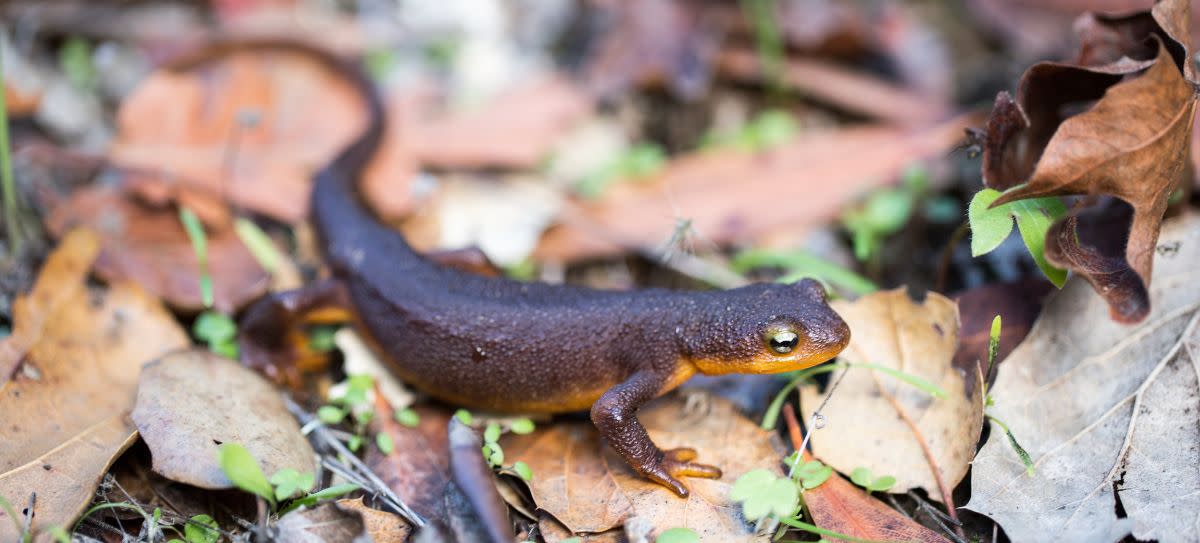 California Newt (Taricha torosa): California Newts have yellowish brown to dark brown backs and pale yellow to orange bellies. Their skin has a warty texture. California Newts measure between 4.9-7.8 inches (12.5-20 centimeters) and males are bigger than females. Characteristic of amphibians, these newts inhabit woodlands and chaparral and small ponds and streams. After mating, females lay their eggs in the shallows of lakes, ponds, and streams.
California Newt (Taricha torosa): California Newts have yellowish brown to dark brown backs and pale yellow to orange bellies. Their skin has a warty texture. California Newts measure between 4.9-7.8 inches (12.5-20 centimeters) and males are bigger than females. Characteristic of amphibians, these newts inhabit woodlands and chaparral and small ponds and streams. After mating, females lay their eggs in the shallows of lakes, ponds, and streams.
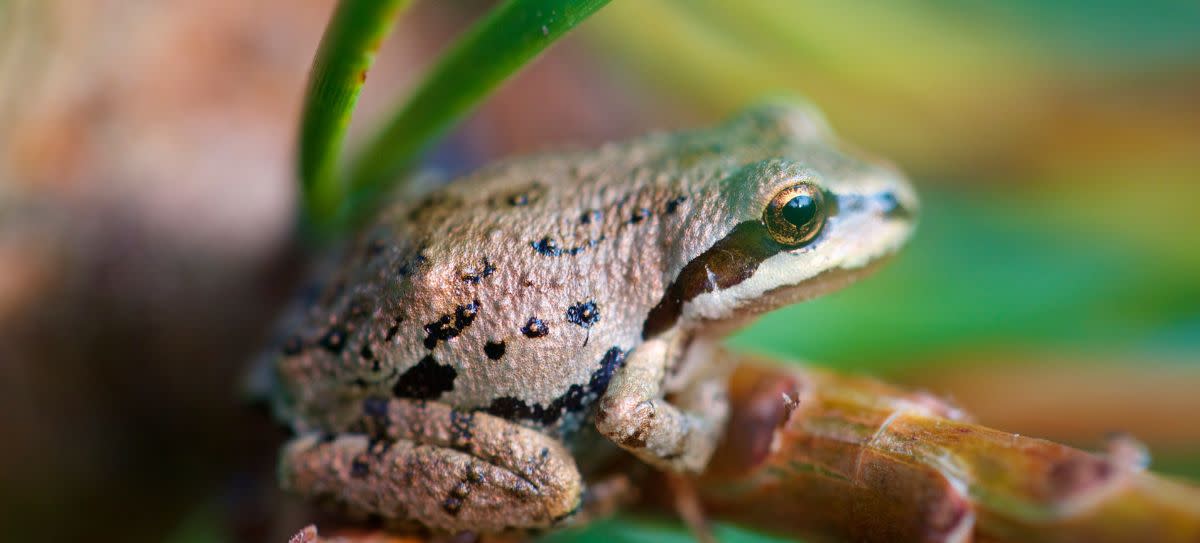 Pacific Treefrog (Pseudacris regilla): Pacific Tree Frogs are small frogs that range in size from 1-1 ⅞ inches with females being slightly larger than males. These frogs are predominantly green with brown to black markings vertically covering their eyes and backs. Tadpoles feed on plant matter while adult frogs eat small insects, like flies and mosquitoes. Pacific Tree Frogs are found in forests by streams, ponds, swamps, and other water sources.
Pacific Treefrog (Pseudacris regilla): Pacific Tree Frogs are small frogs that range in size from 1-1 ⅞ inches with females being slightly larger than males. These frogs are predominantly green with brown to black markings vertically covering their eyes and backs. Tadpoles feed on plant matter while adult frogs eat small insects, like flies and mosquitoes. Pacific Tree Frogs are found in forests by streams, ponds, swamps, and other water sources.
 Slender Salamander (Batrachoseps attenuatus): The California Slender Salamander has a worm-like appearance with a long, skinny body and very short limbs. Their bodies are primarily brown to black with a thick red stripe that trails from their heads to the end of their tails. They range in length from 1.77-5.43 inches (4.5-13.8 centimeters). The California Slender Salamander occupies a diverse range of habitats, from forests, chaparral, woodlands, and urban areas.
Slender Salamander (Batrachoseps attenuatus): The California Slender Salamander has a worm-like appearance with a long, skinny body and very short limbs. Their bodies are primarily brown to black with a thick red stripe that trails from their heads to the end of their tails. They range in length from 1.77-5.43 inches (4.5-13.8 centimeters). The California Slender Salamander occupies a diverse range of habitats, from forests, chaparral, woodlands, and urban areas.
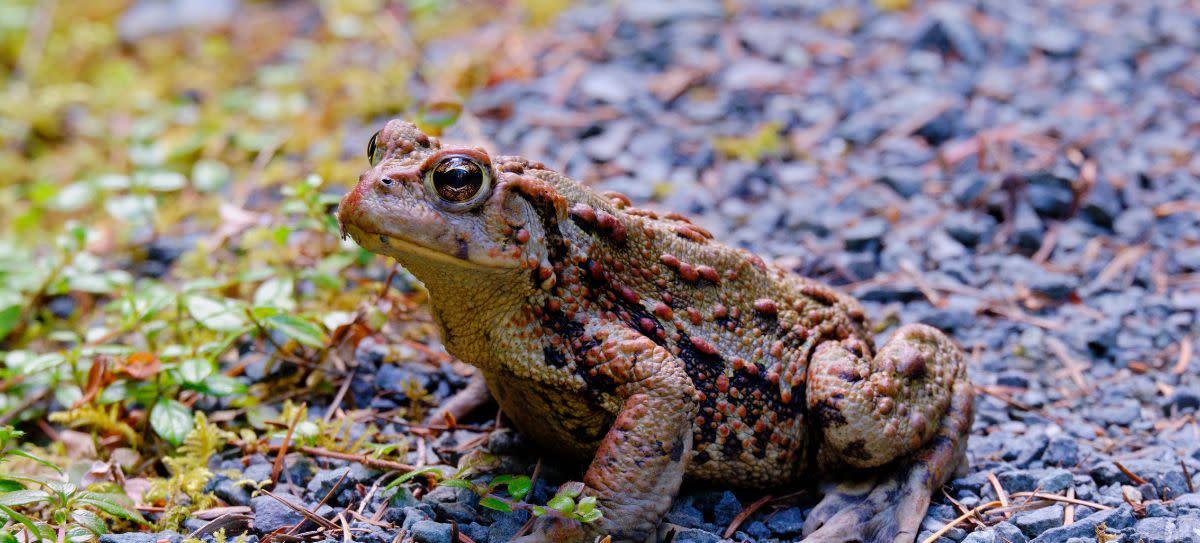 Western Toad (Anaxyrus boreas): Western Toads are gray-green with dark brown to black markings, a cream-colored stripe down their back, and large warts that rise from the dark markings. These toads are between 2.2 and 5.1 inches in length (5.6-13 centimeters) and are considered to be large toads. Western Toad eat a variety of insects and arachnids, and sometimes crayfish. Western Toads inhabit a wide variety of environments, including desert streams, meadows, forests.
Western Toad (Anaxyrus boreas): Western Toads are gray-green with dark brown to black markings, a cream-colored stripe down their back, and large warts that rise from the dark markings. These toads are between 2.2 and 5.1 inches in length (5.6-13 centimeters) and are considered to be large toads. Western Toad eat a variety of insects and arachnids, and sometimes crayfish. Western Toads inhabit a wide variety of environments, including desert streams, meadows, forests.
REPTILES
Reptiles are vertebrate animals that rely on their surroundings for warmth, and are referred to as cold-blooded because of this characteristic; vertebrate animals have backbones. Reptiles breathe using lungs, lay eggs, and their bodies are covered in dry skin, scales, or hard plates.
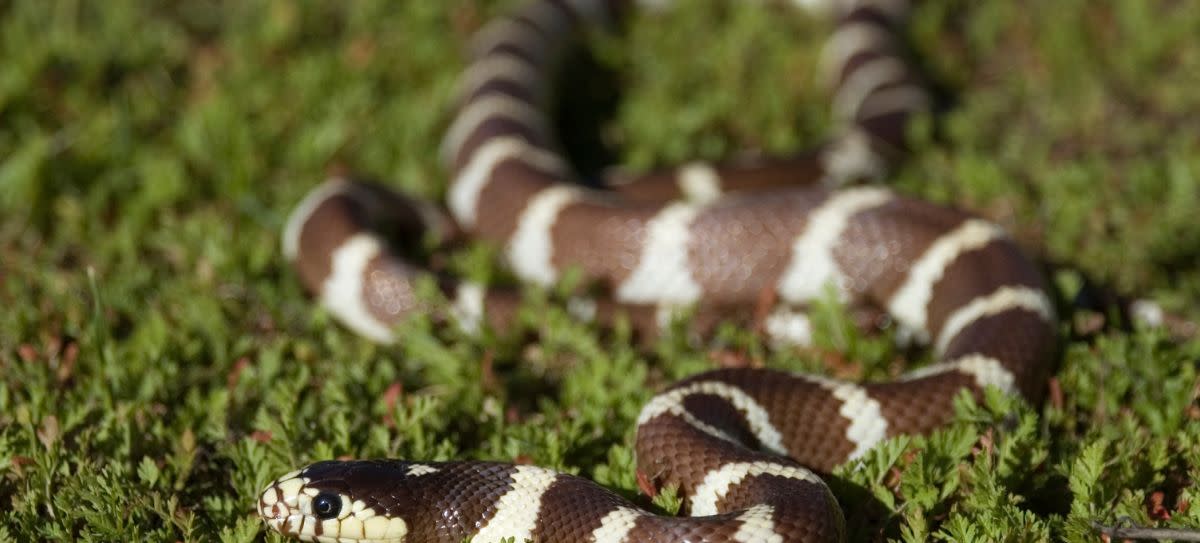 California Kingsnake (Lampropeltis getula californiae): The California Kingsnake is a non-venomous, non-aggressive snake identified by its alternating light and dark bands of black, white, and brown, and white underbellies. These snakes range from 35.82 to 41.73 inches in length (91 to 106 centimeters). California Kingsnakes feed on rodents, lizards, and other snakes. Lacking venom, these snakes kill their prey using constriction. California Kingsnakes inhabit chaparral, deserts, marshes, and urban areas.
California Kingsnake (Lampropeltis getula californiae): The California Kingsnake is a non-venomous, non-aggressive snake identified by its alternating light and dark bands of black, white, and brown, and white underbellies. These snakes range from 35.82 to 41.73 inches in length (91 to 106 centimeters). California Kingsnakes feed on rodents, lizards, and other snakes. Lacking venom, these snakes kill their prey using constriction. California Kingsnakes inhabit chaparral, deserts, marshes, and urban areas.
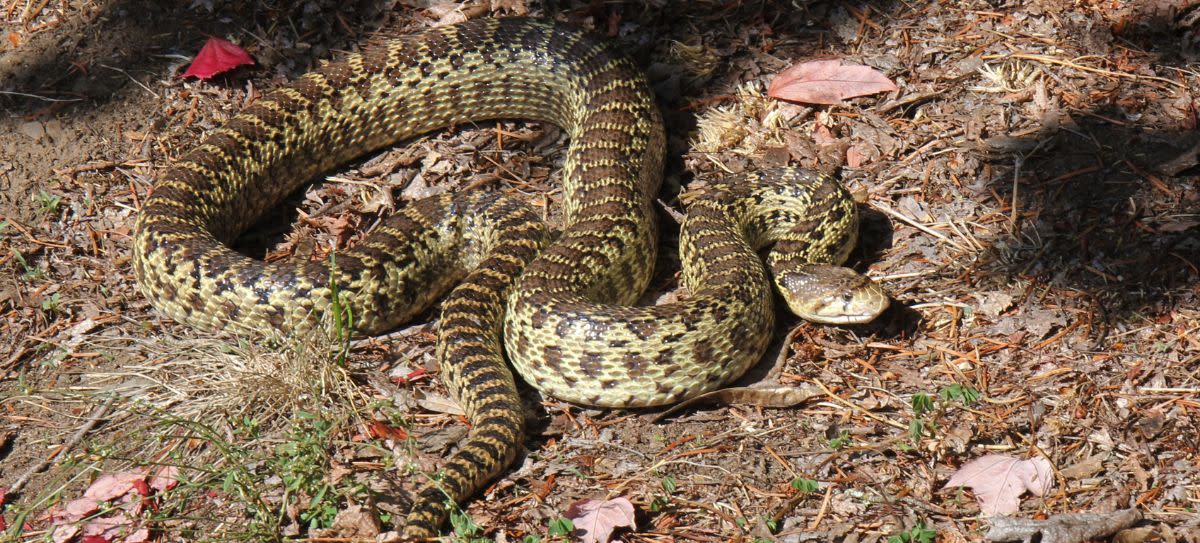 Gopher Snake (Pituophis catenifer catenifer): The Gopher Snake is a non-venomous, non-aggressive snake that is identified by its large eyes, wide heads, markings that graduate from brown to dark brown, and yellow underbellies. Adult Gopher Snakes measure between 70.87 and 108.27 inches (180-275 centimeters) long. Gopher Snakes use constriction to kill their prey which consists of small rodents, like gophers, birds and their eggs, lizards, and insects. When threatened, Gopher Snakes mimic rattlesnakes which can scare humans and result in humans mistaking them for rattlesnakes and killing them. Gopher snakes inhabit woodlands, deserts, agricultural areas, prairies, chaparral, and shrublands.
Gopher Snake (Pituophis catenifer catenifer): The Gopher Snake is a non-venomous, non-aggressive snake that is identified by its large eyes, wide heads, markings that graduate from brown to dark brown, and yellow underbellies. Adult Gopher Snakes measure between 70.87 and 108.27 inches (180-275 centimeters) long. Gopher Snakes use constriction to kill their prey which consists of small rodents, like gophers, birds and their eggs, lizards, and insects. When threatened, Gopher Snakes mimic rattlesnakes which can scare humans and result in humans mistaking them for rattlesnakes and killing them. Gopher snakes inhabit woodlands, deserts, agricultural areas, prairies, chaparral, and shrublands.
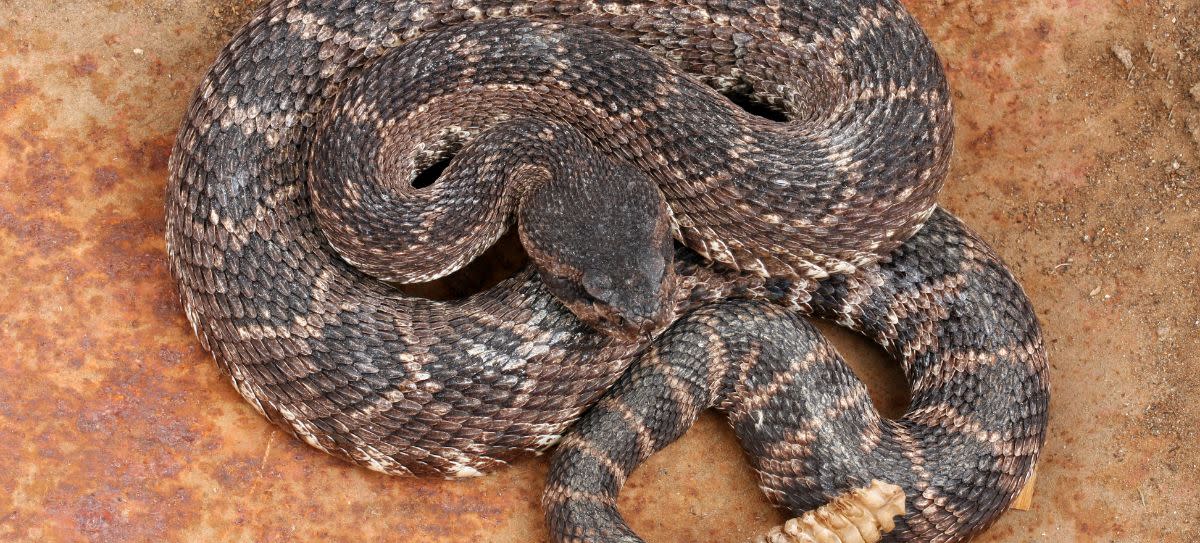 Northern Pacific Rattlesnake (Crotalus oreganus): The Northern Pacific Rattlesnake, also known as the Western Rattlesnake, is a shy and reclusive venomous snake that inhabits dry, rocky terrain, cool forests, and sagebrush in California. Northern Pacific Rattlesnakes are predominantly gray, brown, olive-brown, or black and marked by large, wide dark spots that are separated by light, cream-colored scales. The spots transition to alternating rings of light and dark at the start of their tail and at the end of their ringed tail is a rattle. Adult Northern Pacific Rattlesnakes are between 15 and 36 inches long (31-91 centimeters long) and these snakes feed on birds, frogs, lizards, and small mammals, like mice and rabbits. Northern Pacific Rattlesnakes lay in wait for their prey, strike them with their venomous bite, then after releasing the prey, they follow their prey with their thermal sensors before swallowing it whole.
Northern Pacific Rattlesnake (Crotalus oreganus): The Northern Pacific Rattlesnake, also known as the Western Rattlesnake, is a shy and reclusive venomous snake that inhabits dry, rocky terrain, cool forests, and sagebrush in California. Northern Pacific Rattlesnakes are predominantly gray, brown, olive-brown, or black and marked by large, wide dark spots that are separated by light, cream-colored scales. The spots transition to alternating rings of light and dark at the start of their tail and at the end of their ringed tail is a rattle. Adult Northern Pacific Rattlesnakes are between 15 and 36 inches long (31-91 centimeters long) and these snakes feed on birds, frogs, lizards, and small mammals, like mice and rabbits. Northern Pacific Rattlesnakes lay in wait for their prey, strike them with their venomous bite, then after releasing the prey, they follow their prey with their thermal sensors before swallowing it whole.
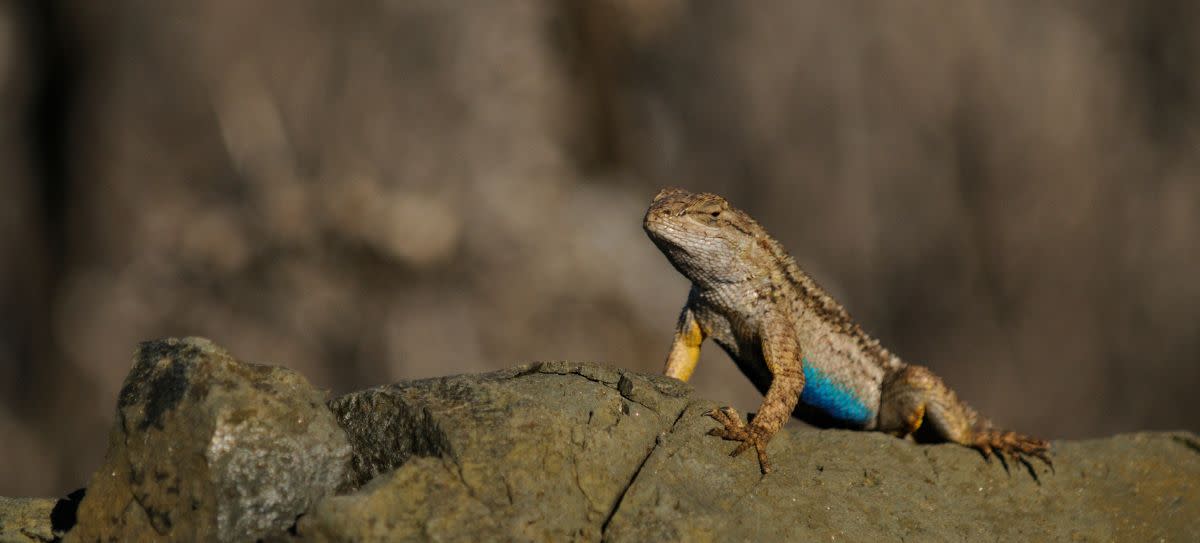 Western Fence Lizard (Sceloporus occidentalis): There are five subspecies within California of Western Fence Lizards. Males are brown to black in color with a bright blue belly and patch on their throats, while females either lack this coloration or have a very faint coloration. The scales of this lizard overlap and are covered in spines. Not including their tails, the Western Fence Lizard measures between 2.25 to 3.5 inches long (5.7-8.9 centimeters). These lizards feed on small invertebrates like crickets, spiders, scorpions, crickets, and sometimes other small lizards. The Western Fence Lizard lives in a variety of environments, such as a chaparral, forests, urban areas, and rocky sites, with an overall preference for warm, sunny areas.
Western Fence Lizard (Sceloporus occidentalis): There are five subspecies within California of Western Fence Lizards. Males are brown to black in color with a bright blue belly and patch on their throats, while females either lack this coloration or have a very faint coloration. The scales of this lizard overlap and are covered in spines. Not including their tails, the Western Fence Lizard measures between 2.25 to 3.5 inches long (5.7-8.9 centimeters). These lizards feed on small invertebrates like crickets, spiders, scorpions, crickets, and sometimes other small lizards. The Western Fence Lizard lives in a variety of environments, such as a chaparral, forests, urban areas, and rocky sites, with an overall preference for warm, sunny areas.
BIRDS
Birds are warm-blooded vertebrates belonging to the class Aves and are more closely related to reptiles than mammals. Distinct characteristics of birds are their feathers, hard shelled eggs, and hollow bones; many birds also exhibit similar courtship, nesting, parenting, and territorial characteristics. Unlike reptiles, birds have the ability to regulate their body temperature from the inside, known as endothermy. Their feathers prevent heat loss and reduce air friction for flight. Birds’ front limbs are their wings and their hind quarters, or legs, are used for perching, walking, hopping, grasping, wading, and swimming. Their legs are covered in epidermal scales. They have no teeth as their upper and lower jaws form their beak. They have very keen eyesight and one middle ear bone. Bird watching is a fascinating and fun activity at the Pismo Preserve!
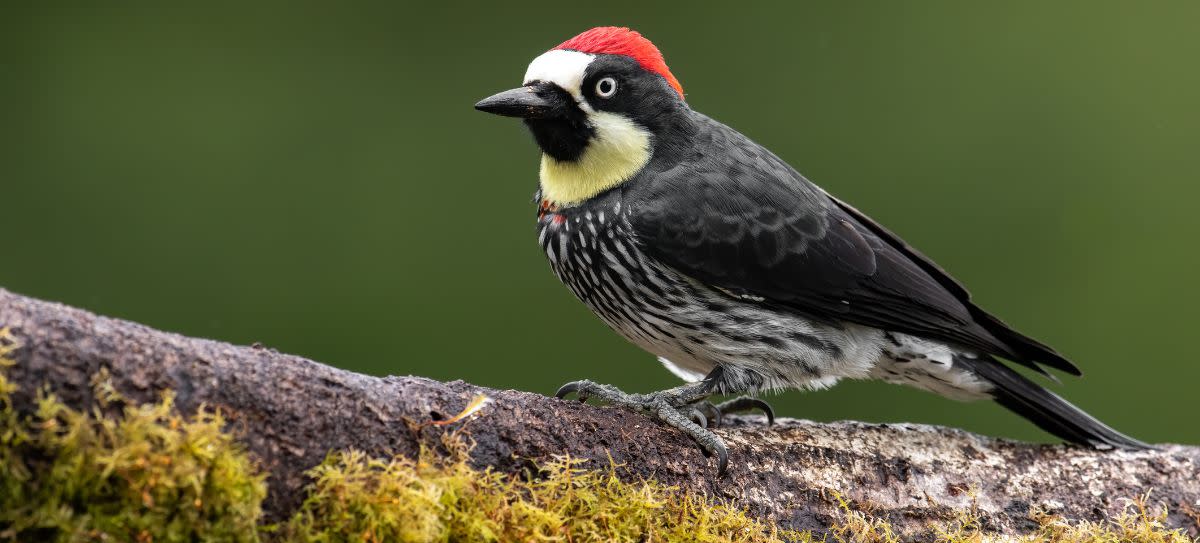 Acorn Woodpecker (Melanerpes formicivorus): The Acorn Woodpecker is a medium-sized bird with a black and white face, a red crown, shiny black back, and a white fluffy chest speckled with black. The wingspan of the Acorn Woodpecker is between 5 and 6 inches wide (13-15 centimeters). As suggested by its name, the Acorn Woodpecker inhabits oak tree heavy woods where it lives on acorns, sap, nectar, and insects. In California, these woodpeckers form large social groups to protect their shared inventory of food that they store in tree hollows.
Acorn Woodpecker (Melanerpes formicivorus): The Acorn Woodpecker is a medium-sized bird with a black and white face, a red crown, shiny black back, and a white fluffy chest speckled with black. The wingspan of the Acorn Woodpecker is between 5 and 6 inches wide (13-15 centimeters). As suggested by its name, the Acorn Woodpecker inhabits oak tree heavy woods where it lives on acorns, sap, nectar, and insects. In California, these woodpeckers form large social groups to protect their shared inventory of food that they store in tree hollows.
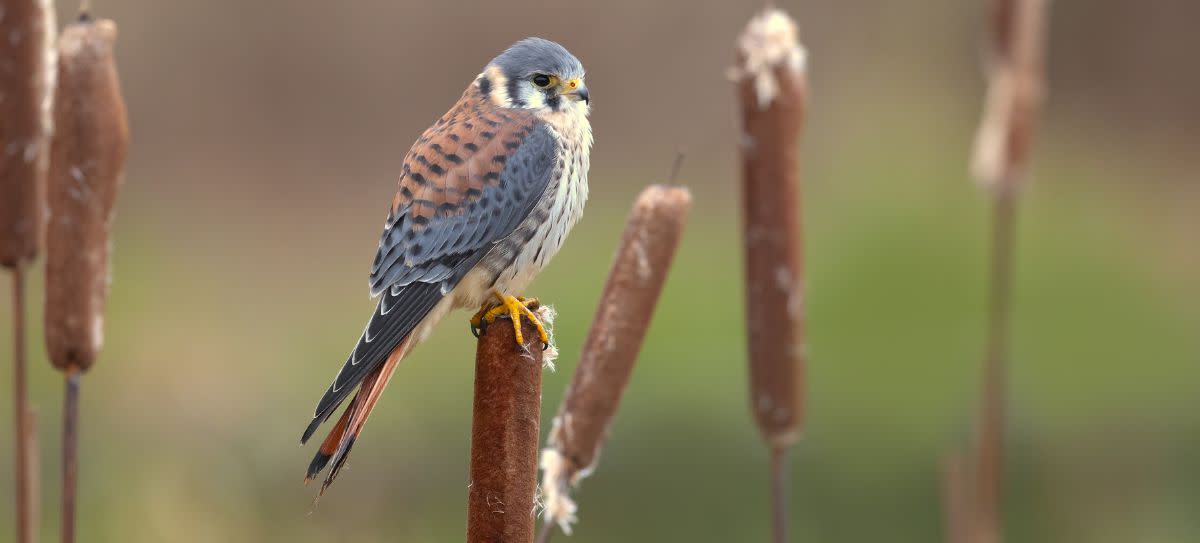 American Kestrel (Falco sparverius): The American Kestrel is a small falcon. Male American Kestrels have russet-colored bodies with silvery-blue wings that are spotted with white speckles. Females have russet-colored bodies and wings that are delineated with black banding. Their faces have characteristic vertical black streaks. These birds inhabit a wide variety of environments, including urban areas, forests, fields, deserts, and mountains. Their wingspan is between 20 to 24 inches in width (51-61 centimeters). American Kestrels feed on insects and small mammals and catch their prey while in flight or after dive-bombing them from a high area.
American Kestrel (Falco sparverius): The American Kestrel is a small falcon. Male American Kestrels have russet-colored bodies with silvery-blue wings that are spotted with white speckles. Females have russet-colored bodies and wings that are delineated with black banding. Their faces have characteristic vertical black streaks. These birds inhabit a wide variety of environments, including urban areas, forests, fields, deserts, and mountains. Their wingspan is between 20 to 24 inches in width (51-61 centimeters). American Kestrels feed on insects and small mammals and catch their prey while in flight or after dive-bombing them from a high area.
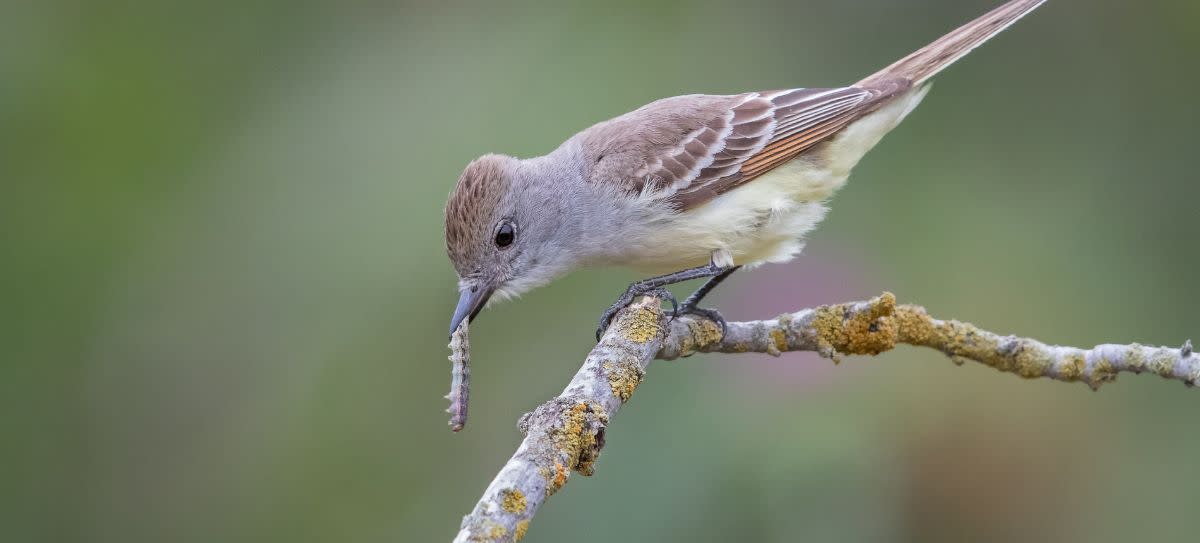 Ash-throated Flycatcher (Myiarchus cinerascens): Ash-throated Flycatchers have brown heads and backs, white necks and chests, light yellow bellies, brown wings with russet tinges, and a long, straight tail. Their wingspan is about 11.81 to 12.60 inches wide (30-32 centimeters). They are referred to as “flycatchers” because they catch and eat flies and many other insects, particularly flying ants, bees, and wasps. The size of the prey being caught depends on the size of the flycatcher, with large flycatchers preying on larger insects, medium-sized flycatchers taking slightly smaller prey, and small flycatchers catching the smallest insects. Ash-throated Flycatchers are spring and fall migrants. During this time, they nest in a variety of lowland habitats, like mesquite groves, pinyon-juniper hillsides, and other open woodlands but avoiding mountains.
Ash-throated Flycatcher (Myiarchus cinerascens): Ash-throated Flycatchers have brown heads and backs, white necks and chests, light yellow bellies, brown wings with russet tinges, and a long, straight tail. Their wingspan is about 11.81 to 12.60 inches wide (30-32 centimeters). They are referred to as “flycatchers” because they catch and eat flies and many other insects, particularly flying ants, bees, and wasps. The size of the prey being caught depends on the size of the flycatcher, with large flycatchers preying on larger insects, medium-sized flycatchers taking slightly smaller prey, and small flycatchers catching the smallest insects. Ash-throated Flycatchers are spring and fall migrants. During this time, they nest in a variety of lowland habitats, like mesquite groves, pinyon-juniper hillsides, and other open woodlands but avoiding mountains.
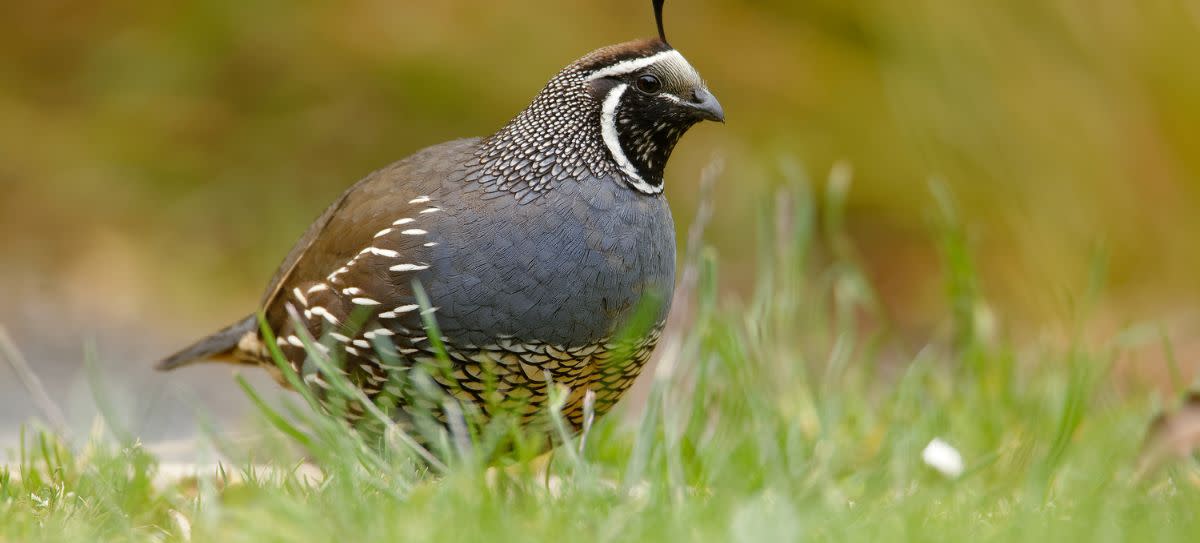 California Quail (Callipepla californica): The California Quail is the official state bird of California. The California Quail is a small, round bird with a gray back, gray throat, scale-patterned brown chest, and a characteristic black feather plume atop its head. These quails grow to be about 9.5 inches in length (25 centimeters). California Quails inhabit woods, brushlands, foothills, agricultural areas, and residential areas. California Quails forage for seeds, insects, and sometimes fruit.
California Quail (Callipepla californica): The California Quail is the official state bird of California. The California Quail is a small, round bird with a gray back, gray throat, scale-patterned brown chest, and a characteristic black feather plume atop its head. These quails grow to be about 9.5 inches in length (25 centimeters). California Quails inhabit woods, brushlands, foothills, agricultural areas, and residential areas. California Quails forage for seeds, insects, and sometimes fruit.
 California Scrub Jay (Aphelocoma californica): The California Scrub Jay is a species in the bird family called Corvidae or corvids. Corvids are very intelligent and include crows, ravens, jays, and magpies. The California Scrub Jay has a bright blue head, wings, and tail, gray shoulders, cream-colored belly, and a black face with white “eyebrows”. Male California Scrub Jays are slightly larger than females with adult Jays measuring about 11.5 inches long (29.21 centimeters). California Scrub Jays have a varied diet made up of seeds, fruit, berries, insects, and other birds and their eggs. These Jays can be found in suburban areas, woodlands, and oak and pine forests.
California Scrub Jay (Aphelocoma californica): The California Scrub Jay is a species in the bird family called Corvidae or corvids. Corvids are very intelligent and include crows, ravens, jays, and magpies. The California Scrub Jay has a bright blue head, wings, and tail, gray shoulders, cream-colored belly, and a black face with white “eyebrows”. Male California Scrub Jays are slightly larger than females with adult Jays measuring about 11.5 inches long (29.21 centimeters). California Scrub Jays have a varied diet made up of seeds, fruit, berries, insects, and other birds and their eggs. These Jays can be found in suburban areas, woodlands, and oak and pine forests.
 Great Horned Owl (Bubo virginianus): The Great Horned Owl, often referred to as the Cat Owl, is rarely mistaken for any other owl. It possesses very distinct physical characteristics with large ear tufts that resemble horns or cat ears, a white throat, light colored feathers on the inside of its wings, and brown feathers covering its body, and can grow up to 22 inches long. A mature Great Horned Owl makes a deep hooting call, whilst the young make a raucous, raspy screeching. Nests are made in tree hollows or cavities, or are made in the nests that other larger birds have abandoned. Nests are also established in caves, tree stumps, rock ledges and hollows, and structures such as barns. Nests are not occupied by the same owl for more than two years consecutively. Female owls lay 2 to 3 eggs, incubating the eggs for 26 to 35 days. Her mate will feed her during the incubation period. Both parents will feed their hatchlings for 4 to 5 weeks while their young begin to learn to fly. By 9 weeks, the young Great Horned Owls can fly sufficiently, and can have a lifespan of up to 28 years in the wild. Great Horned Owls are found across the United States and Canada. To avoid the harsh winter, Great Horned Owls may migrate from Canada, south the Northern United States where they can be found in woodlands, shrublands, deserts, forests and cliffsides. Great Horned Owls are carnivores and spend most of their time hunting and watching from the trees, and fly silently down to catch their prey. They have better night vision, but hunt both during the night and day, eating small mammals like mice, rabbits, squirrels and skunks. They will also consume other birds like hawks and ducks.
Great Horned Owl (Bubo virginianus): The Great Horned Owl, often referred to as the Cat Owl, is rarely mistaken for any other owl. It possesses very distinct physical characteristics with large ear tufts that resemble horns or cat ears, a white throat, light colored feathers on the inside of its wings, and brown feathers covering its body, and can grow up to 22 inches long. A mature Great Horned Owl makes a deep hooting call, whilst the young make a raucous, raspy screeching. Nests are made in tree hollows or cavities, or are made in the nests that other larger birds have abandoned. Nests are also established in caves, tree stumps, rock ledges and hollows, and structures such as barns. Nests are not occupied by the same owl for more than two years consecutively. Female owls lay 2 to 3 eggs, incubating the eggs for 26 to 35 days. Her mate will feed her during the incubation period. Both parents will feed their hatchlings for 4 to 5 weeks while their young begin to learn to fly. By 9 weeks, the young Great Horned Owls can fly sufficiently, and can have a lifespan of up to 28 years in the wild. Great Horned Owls are found across the United States and Canada. To avoid the harsh winter, Great Horned Owls may migrate from Canada, south the Northern United States where they can be found in woodlands, shrublands, deserts, forests and cliffsides. Great Horned Owls are carnivores and spend most of their time hunting and watching from the trees, and fly silently down to catch their prey. They have better night vision, but hunt both during the night and day, eating small mammals like mice, rabbits, squirrels and skunks. They will also consume other birds like hawks and ducks.
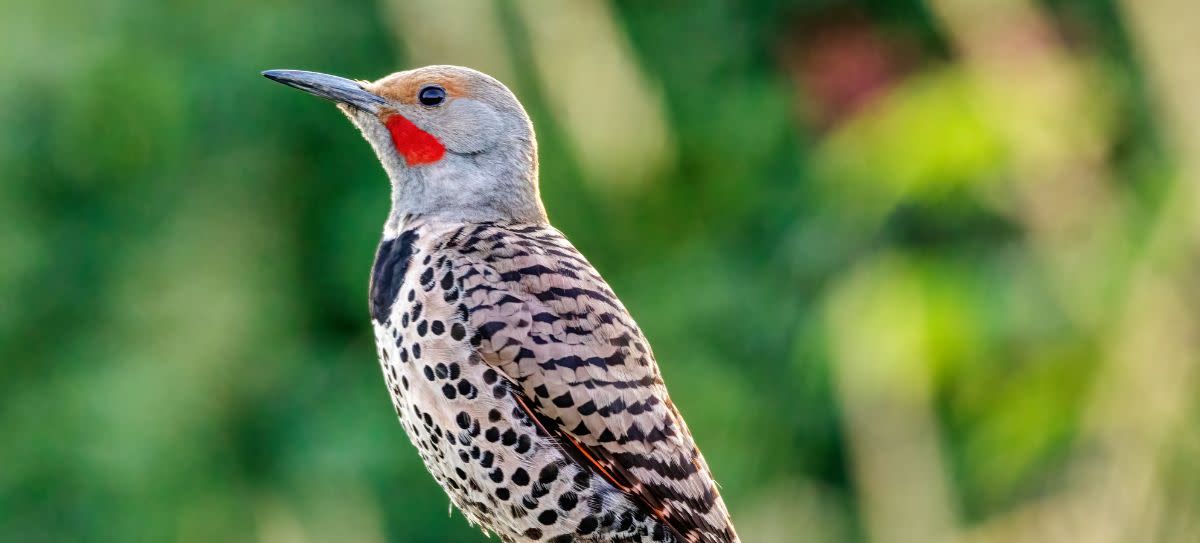 Northern Flicker (Colaptes auratus): The Northern Flicker is a medium-sized woodpecker. There are different subspecies of Northern Flickers which leads to color variations between the subspecies but the most commonly spotted Northern Flicker on the American West Coast is the Red-Shafted Flicker. The Red-Shafted Flicker has a light brown barred back, a brown spotted front, a red mustache that descends down their cheeks, reddish underwings, and a russet-colored crown. The wingspan of an adult Northern Flicker is about 21 inches wide (54 centimeters). Northern Flickers are omnivores, meaning they eat both animals and plants, and they enjoy a diet of mostly ants, fruits, and small insects. These woodpeckers are found in woods with dead trees, agricultural areas, and suburban areas.
Northern Flicker (Colaptes auratus): The Northern Flicker is a medium-sized woodpecker. There are different subspecies of Northern Flickers which leads to color variations between the subspecies but the most commonly spotted Northern Flicker on the American West Coast is the Red-Shafted Flicker. The Red-Shafted Flicker has a light brown barred back, a brown spotted front, a red mustache that descends down their cheeks, reddish underwings, and a russet-colored crown. The wingspan of an adult Northern Flicker is about 21 inches wide (54 centimeters). Northern Flickers are omnivores, meaning they eat both animals and plants, and they enjoy a diet of mostly ants, fruits, and small insects. These woodpeckers are found in woods with dead trees, agricultural areas, and suburban areas.
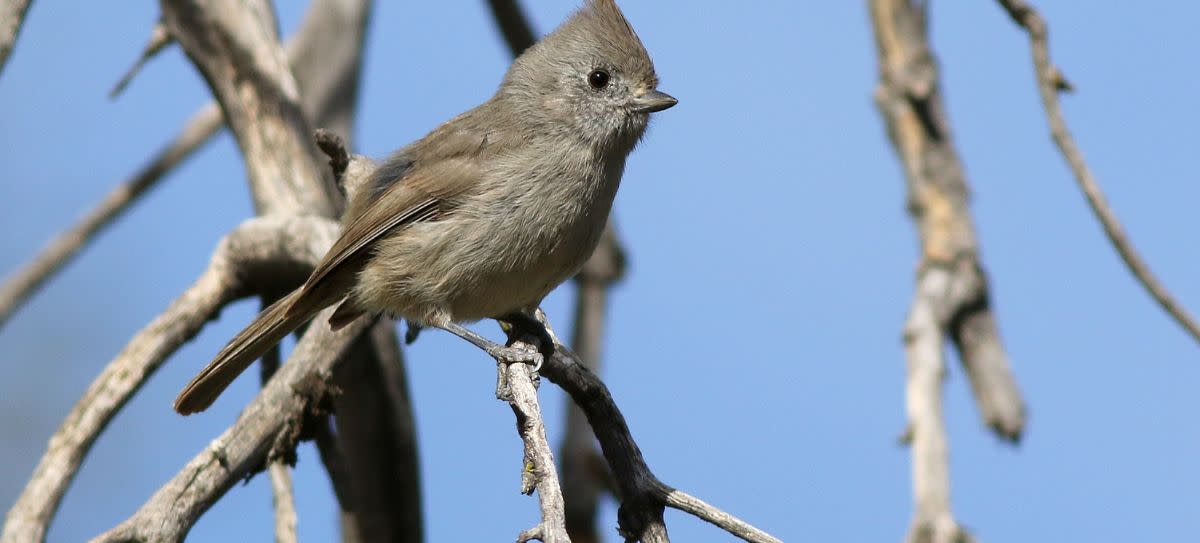 Oak Titmouse (Baeolophus inornatus): The Oak Titmouse is a small, ash brown bird with a light-colored belly, and small triangular crest on its head. They have small, short beaks and long tails. The wingspan of an Oak Titmouse is about 9 inches in width (23 centimeters). These birds enjoy insects, acorns, and berries. Oak Titmouses live in oak forests where they roost in cavities, foliage, and even birdhouses.
Oak Titmouse (Baeolophus inornatus): The Oak Titmouse is a small, ash brown bird with a light-colored belly, and small triangular crest on its head. They have small, short beaks and long tails. The wingspan of an Oak Titmouse is about 9 inches in width (23 centimeters). These birds enjoy insects, acorns, and berries. Oak Titmouses live in oak forests where they roost in cavities, foliage, and even birdhouses.
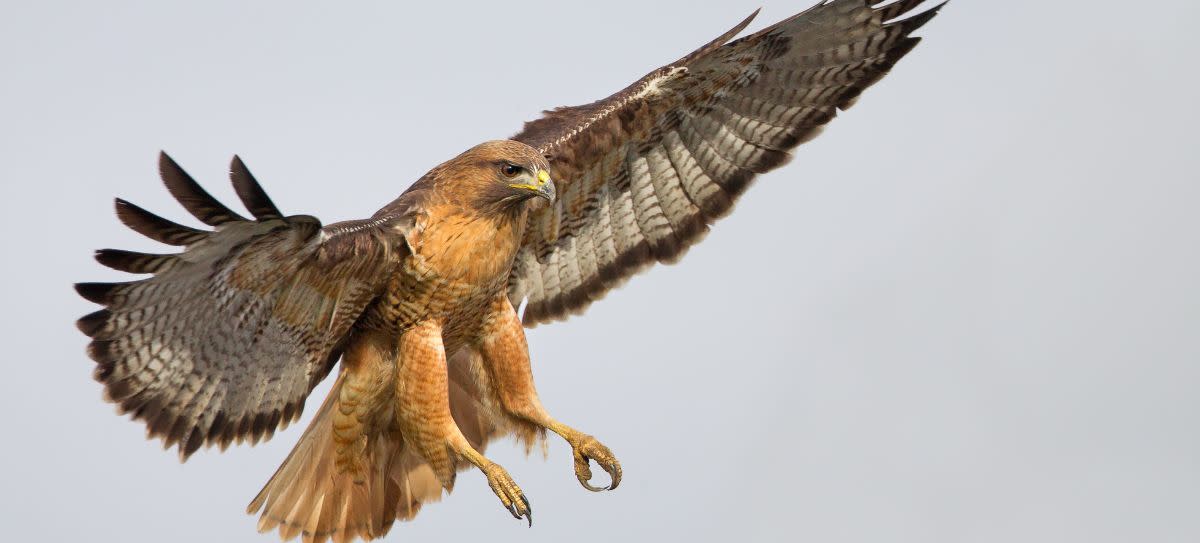 Red-tailed Hawk (Buteo jamaicensis): The Red-tailed Hawk is a magnificent bird of prey, identified by its light reddish-brown tail feathers. Red-tailed Hawks have russet heads, backs, and wings that are barred by dark brown lines. The underside of the faces, wings, and bellies are cream-colored with dark banding. Females are larger than males. The wingspan of a Red-tailed Hawk is 4 feet across (1.2 meters). Although Red-tailed Hawks occupy a wide range of habitats, like deserts, residential areas, agricultural areas, woodlands, with open areas with high perches being a common factor in their habitats. High perches are important to Red-tailed Hawks as they capture their prey by swooping down from their perches and grasping their prey with their sharp talons. These birds of prey are carnivores, feeding on rodents, small mammals like squirrels and rabbits, and other birds.
Red-tailed Hawk (Buteo jamaicensis): The Red-tailed Hawk is a magnificent bird of prey, identified by its light reddish-brown tail feathers. Red-tailed Hawks have russet heads, backs, and wings that are barred by dark brown lines. The underside of the faces, wings, and bellies are cream-colored with dark banding. Females are larger than males. The wingspan of a Red-tailed Hawk is 4 feet across (1.2 meters). Although Red-tailed Hawks occupy a wide range of habitats, like deserts, residential areas, agricultural areas, woodlands, with open areas with high perches being a common factor in their habitats. High perches are important to Red-tailed Hawks as they capture their prey by swooping down from their perches and grasping their prey with their sharp talons. These birds of prey are carnivores, feeding on rodents, small mammals like squirrels and rabbits, and other birds.
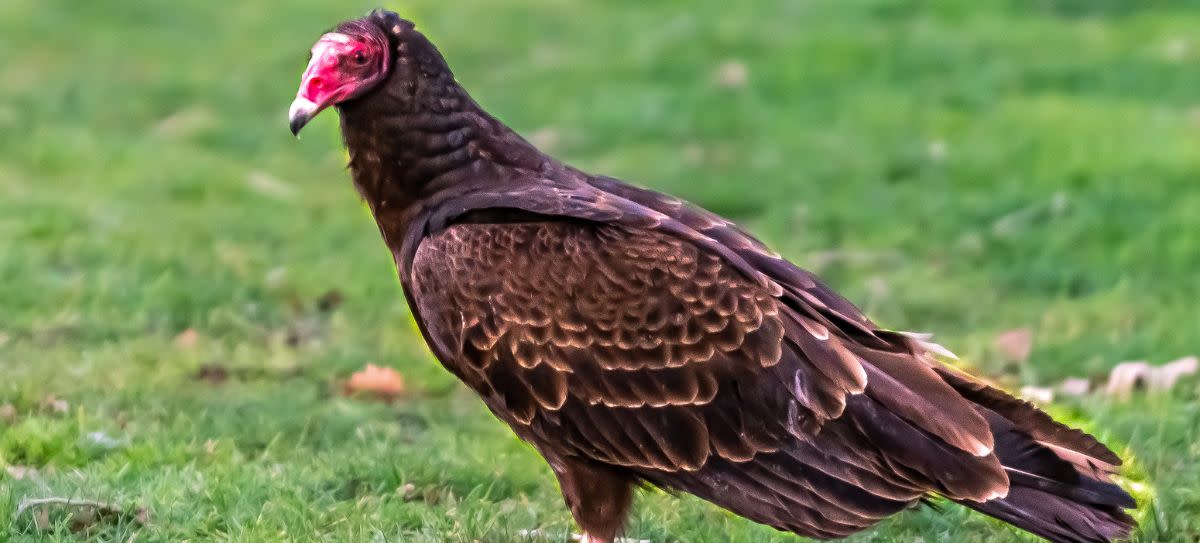 Turkey Vulture (Cathartes aura): Turkey Vultures are scavengers with pink to deep red bald heads, black necks, and dark brown wings with gray undersides. Their wingspans are 66.93 to 72.05 inches in width (170-183 centimeters) which helps them to soar for extended periods of time. Turkey Vultures are carnivorous scavengers so they soar above in search of carrion, or deceased animals, that are often already rotting. They use their sharp eyesight and strong sense of smell to sniff out potential food. This grim dietary preference may seem sinister but Turkey Vultures are very important in helping keep the ecosystem disease and carcass free.
Turkey Vulture (Cathartes aura): Turkey Vultures are scavengers with pink to deep red bald heads, black necks, and dark brown wings with gray undersides. Their wingspans are 66.93 to 72.05 inches in width (170-183 centimeters) which helps them to soar for extended periods of time. Turkey Vultures are carnivorous scavengers so they soar above in search of carrion, or deceased animals, that are often already rotting. They use their sharp eyesight and strong sense of smell to sniff out potential food. This grim dietary preference may seem sinister but Turkey Vultures are very important in helping keep the ecosystem disease and carcass free.
MAMMALS
Mammals are vertebrates, that is, animals that have backbones. They feed their young with milk produced by their mammary glands, have fur or hair, have three middle ear bones, and have the neocortex region of the brain. The neocortex portion of their mammalian brain contributes to voluntary motor control, perception, cognition, and other complex behaviors. Amphibians, reptiles, fish and birds do not have a neocortex region of the brain and have only one middle ear bone. The three small bones in mammals’ ears transmit sounds from the eardrum so mammals can hear high-pitched sounds like bird calls, insects buzzing, and the wind blowing. Reptiles use their one middle ear bone to hear by placing their jaws on the ground picking up low-frequency vibrations.
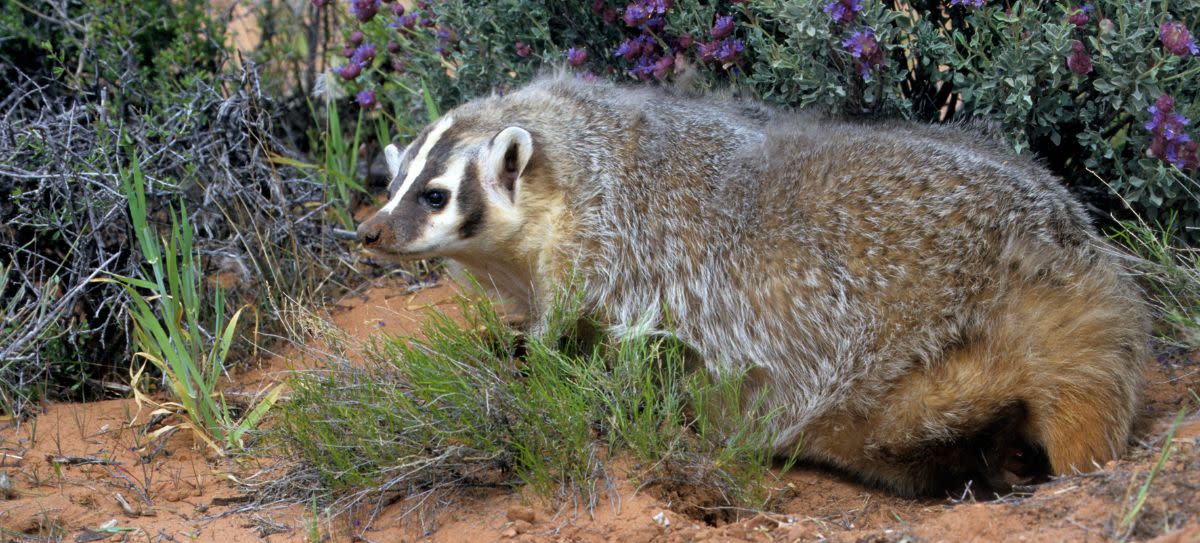 American Badger (Taxidea taxus): The American Badger has a cream-colored face with black stripes and a black head, a cream-colored underside, and a brindled long-haired coat with brown, cream, and black. It has four black legs with long, sharp claws extending from its paws. From head to tail, an adult American Badger is about 20.47 to 34.45 inches in length (52- 88 centimeters). Males are much larger than females. American Badgers are solitary creatures, only pairing together briefly for mating. Badgers are carnivores, eating a variety of small rodents, like gophers and kangaroo rats, ground-nesting birds, lizards, and insects. Badgers use their sharp claws to tunnel into the ground for their prey and to prepare dens to sleep in. American Badgers occupy dry prairies, fields, pastures, chaparral, and deserts.
American Badger (Taxidea taxus): The American Badger has a cream-colored face with black stripes and a black head, a cream-colored underside, and a brindled long-haired coat with brown, cream, and black. It has four black legs with long, sharp claws extending from its paws. From head to tail, an adult American Badger is about 20.47 to 34.45 inches in length (52- 88 centimeters). Males are much larger than females. American Badgers are solitary creatures, only pairing together briefly for mating. Badgers are carnivores, eating a variety of small rodents, like gophers and kangaroo rats, ground-nesting birds, lizards, and insects. Badgers use their sharp claws to tunnel into the ground for their prey and to prepare dens to sleep in. American Badgers occupy dry prairies, fields, pastures, chaparral, and deserts.
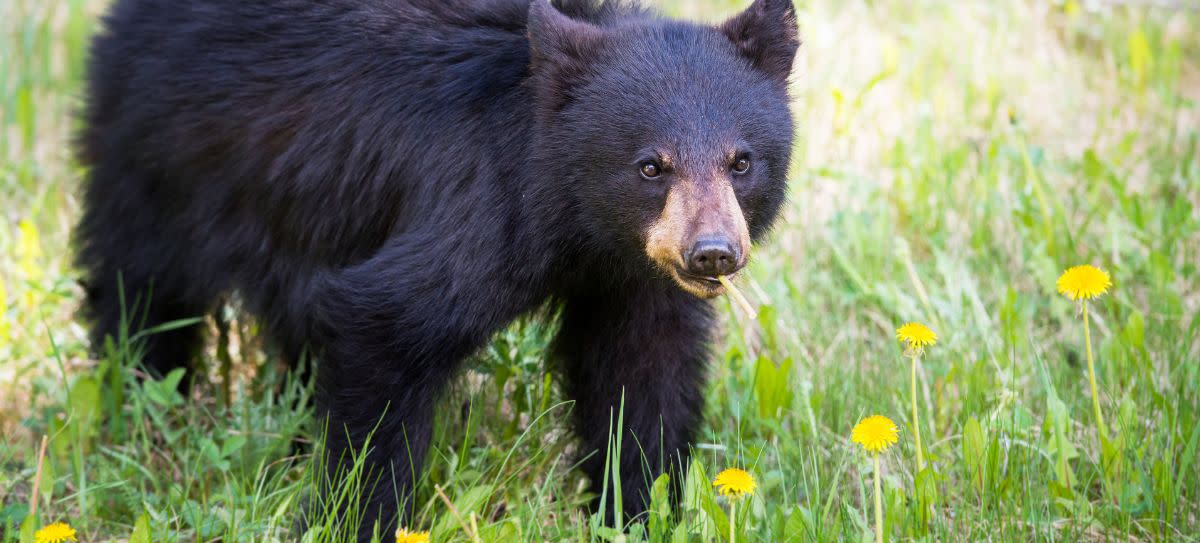 Black Bear (Ursus americanus): While American Black Bears are generally black in color, those on the Western coast of the United States are slightly lighter in color, being brown, bay, and even blonde. Male Black Bears are larger than females with males ranging in length from 55 to 79 inches and females ranging from 47 to 63 inches. Black Bears have longer ears and smaller shoulder humps. Baby bears are called cubs and they are born during their mother’s hibernation through the winter. Black Bears are crepuscular, which means that they are active at twilight. Black Bears are omnivores and their diets vary with the seasons. During the spring, they eat grasses, fruit in the summertime, and in fall, they eat nuts, fruit, and acorns. A small portion of their diet comes from insects, carrion, and fish they catch. The American Black Bear is found in difficult terrain covered in thick shrubbery and forests that contain prairies, meadows, and riparian environments
Black Bear (Ursus americanus): While American Black Bears are generally black in color, those on the Western coast of the United States are slightly lighter in color, being brown, bay, and even blonde. Male Black Bears are larger than females with males ranging in length from 55 to 79 inches and females ranging from 47 to 63 inches. Black Bears have longer ears and smaller shoulder humps. Baby bears are called cubs and they are born during their mother’s hibernation through the winter. Black Bears are crepuscular, which means that they are active at twilight. Black Bears are omnivores and their diets vary with the seasons. During the spring, they eat grasses, fruit in the summertime, and in fall, they eat nuts, fruit, and acorns. A small portion of their diet comes from insects, carrion, and fish they catch. The American Black Bear is found in difficult terrain covered in thick shrubbery and forests that contain prairies, meadows, and riparian environments
 Bobcat (Lynx rufus): Bobcats are medium-sized cats native to North America; their habitat ranges from the high alpine zones to the arid deserts, and traverse southern Canada through the United States to Oaxaca, Mexico. Bobcats are two to three times the size of the average house cat, weighing from 15-25 pounds, with distinctive muscular shoulders, ear tufts, spotted coats, and short, black-tipped “bobbed” tails, that are from 4-6 inches long. Bobcats are largely carnivorous, consuming mainly rabbits, hares, and rodents. Bobcats are very secretive and seldom spotted in the wild. Their main mating season is in the winter. Their gestation is about 60-70 days and their litters have two to four kittens. Throughout the United States, their estimated population size is two to three million individuals.
Bobcat (Lynx rufus): Bobcats are medium-sized cats native to North America; their habitat ranges from the high alpine zones to the arid deserts, and traverse southern Canada through the United States to Oaxaca, Mexico. Bobcats are two to three times the size of the average house cat, weighing from 15-25 pounds, with distinctive muscular shoulders, ear tufts, spotted coats, and short, black-tipped “bobbed” tails, that are from 4-6 inches long. Bobcats are largely carnivorous, consuming mainly rabbits, hares, and rodents. Bobcats are very secretive and seldom spotted in the wild. Their main mating season is in the winter. Their gestation is about 60-70 days and their litters have two to four kittens. Throughout the United States, their estimated population size is two to three million individuals.
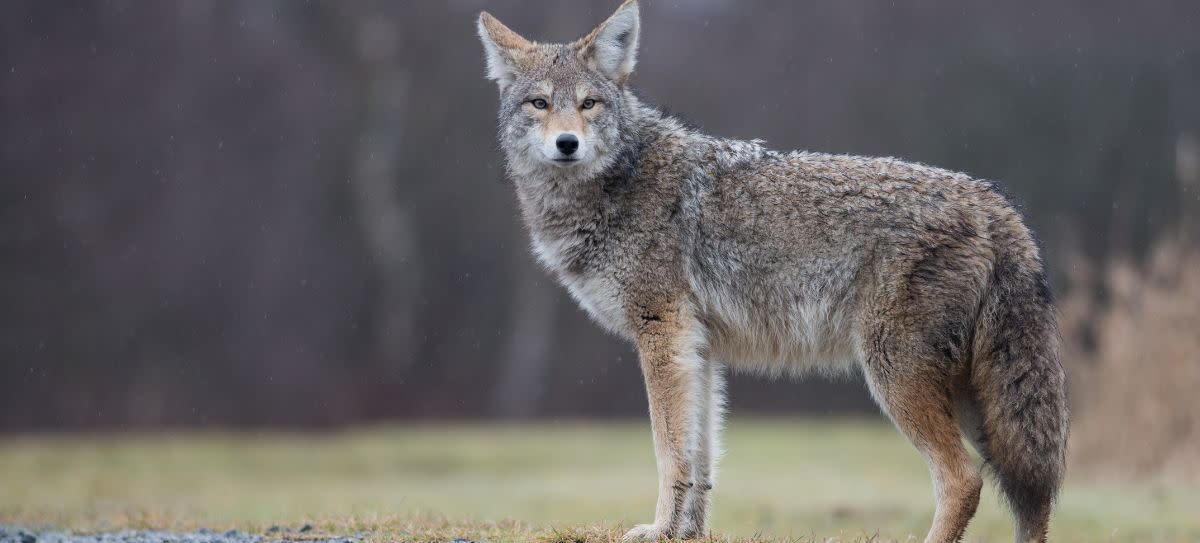 Coyote (Canis latrans): The Coyote is a species of canine native to North America and smaller than its close relative, the wolf. Coyotes weigh from 15 to 46 pounds; measure 1.9 to 2.2 feet tall; can run at speeds of 35 to 43 miles per hour. Coyotes have brown, gray or tan fur with pointed ears and nose, and a long, bushy tail. Coyotes are mainly carnivores, hunting rabbits, mice and deer. However, Coyotes are also eaten by gray wolves, cougars, golden eagles, American black and grizzly bears, American alligators, and large Canada lynxes. Coyotes are pack animals and have litters of up to six pups with one litter per year. In California, coyotes breed January through March with a gestation of 60-63 days. Coyotes live 10 to 14 years in the wild.
Coyote (Canis latrans): The Coyote is a species of canine native to North America and smaller than its close relative, the wolf. Coyotes weigh from 15 to 46 pounds; measure 1.9 to 2.2 feet tall; can run at speeds of 35 to 43 miles per hour. Coyotes have brown, gray or tan fur with pointed ears and nose, and a long, bushy tail. Coyotes are mainly carnivores, hunting rabbits, mice and deer. However, Coyotes are also eaten by gray wolves, cougars, golden eagles, American black and grizzly bears, American alligators, and large Canada lynxes. Coyotes are pack animals and have litters of up to six pups with one litter per year. In California, coyotes breed January through March with a gestation of 60-63 days. Coyotes live 10 to 14 years in the wild.
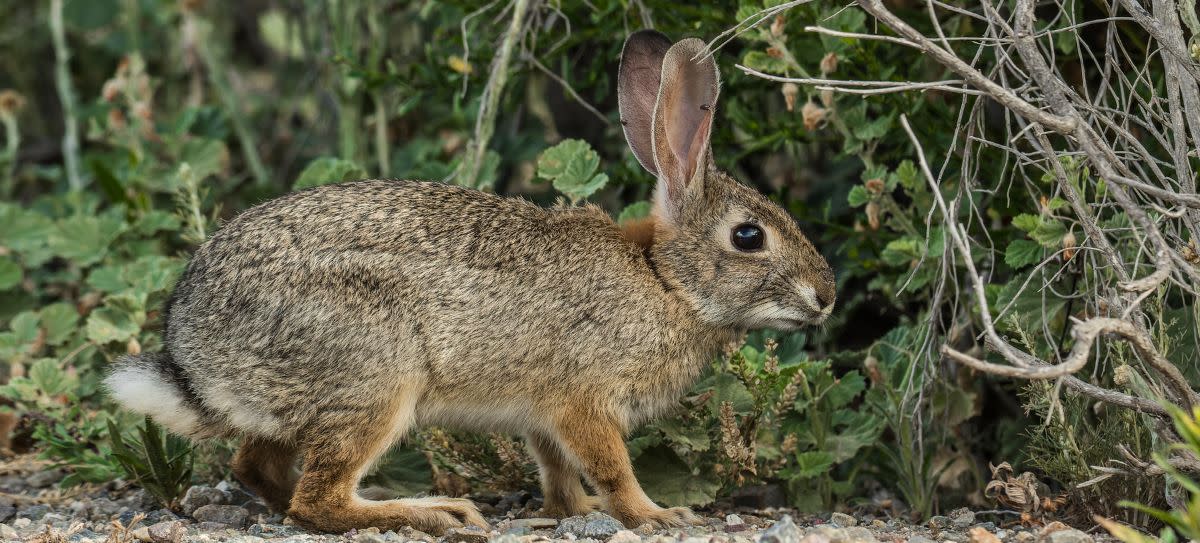 Desert Cottontail (Sylvilagus audubonii): Desert Cottontails, also known as Audubon's cottontail, are a New World cottontail rabbit. Desert Cottontails are found throughout the Western United States inhabiting dry grasslands, shrublands, forests, and along rivers. They are social and gather in small groups to feed, foraging in the early morning and evening. They are herbivores feeding on grass, leaves, barks, fallen fruit, the prickly pear, and twigs. Desert Cottontails have large erect ears and grayish-brown, rounded tails with broad white edges and white undersides and white fur on their bellies. They weigh up to 1.9 pounds and grow to 13 inches in length. They have a gestational period of 28 days and a litter of 1 to 6 babies. Desert Cottontails live up to 2 years of age. Many animals prey on Cottontails, including birds of prey, mustelids, coyotes, bobcats, wolves, mountain lions, snakes, weasels, and humans.
Desert Cottontail (Sylvilagus audubonii): Desert Cottontails, also known as Audubon's cottontail, are a New World cottontail rabbit. Desert Cottontails are found throughout the Western United States inhabiting dry grasslands, shrublands, forests, and along rivers. They are social and gather in small groups to feed, foraging in the early morning and evening. They are herbivores feeding on grass, leaves, barks, fallen fruit, the prickly pear, and twigs. Desert Cottontails have large erect ears and grayish-brown, rounded tails with broad white edges and white undersides and white fur on their bellies. They weigh up to 1.9 pounds and grow to 13 inches in length. They have a gestational period of 28 days and a litter of 1 to 6 babies. Desert Cottontails live up to 2 years of age. Many animals prey on Cottontails, including birds of prey, mustelids, coyotes, bobcats, wolves, mountain lions, snakes, weasels, and humans.

 Deer: Black-Tailed Deer and Mule Deer
Deer: Black-Tailed Deer and Mule Deer
Whitetail and Mule Deer are closely related and belong to the same taxonomic genus, Odocoileus, making it possible for them to interbreed. Both Black-tailed and Mule Deer have large ears and that is why they are referred to as “mule deer”. Like most deer, both deer are browsers and prefer eating shrubs and trees rather than grazing on grasses.
Deer - Black-tailed Deer (Odocoileus hemionus columbianus): Black-tailed deer are subspecies of Mule Deer. The Bllack-tailed Deer lives along the Pacific coast from California and Alaska. It is a very popular game animal and lives on the edge of the forest browsing on western poison oak, douglas fir, red cedar, huckleberry, salal, deer fern, grasses, berries, apples, maple, and lichens growing on trees. The deer are active from dawn to dusk. The gestation period for does (female deer) is 6–7 months, with fawns (infant deers) being born in late May and into June. Most does have twins, with young does having a single fawn, and triplets can also occur. Fawns weigh 6.0 to 8.8 pounds and have no scent for the first week, so the does can leave the fawn hidden from predators while they find food.
Deer - Mule Deer (O.h. hemionus): The Mule Deer is a deer indigenous to western North America and is named for its ears, which are large like mule ears. Mule Deer are tannish brown in the summer. Mule Deer weigh 120 to 330 pounds for adult males and 95 to 200 pounds for adult female deer. The gestation period for mule deers is 203 days. Mule Deers are herbivores. In North America, many large predators prey on Mule Deers. They primarily consist of mountain lions, coyotes, and bobcats, although black bears, wolves, grizzly bears, and feral dogs will also hunt mule deer.
 Dusky-footed Woodrat (Neotoma fuscipes): The Dusky-footed Woodrat is a sandy-brown colored rat with a cream-colored belly, a thick, long dark brown tail, and light pink feet. Dusky-footed Woodrats are sexually-dimorphic, meaning that there is a size difference between male and females. Males are about 17 inches long (44.3 centimeters) and females are about 15 inches (38.5 centimeters) in length.
Dusky-footed Woodrat (Neotoma fuscipes): The Dusky-footed Woodrat is a sandy-brown colored rat with a cream-colored belly, a thick, long dark brown tail, and light pink feet. Dusky-footed Woodrats are sexually-dimorphic, meaning that there is a size difference between male and females. Males are about 17 inches long (44.3 centimeters) and females are about 15 inches (38.5 centimeters) in length.
These wood-rats live in heavily tree-lined forests and thick chaparral areas which offer them protection from predators. Dusky-footed Woodrats build large complex cone-shaped nests out of branches, vegetation, and bark. While these woodrats are solitary creatures, except during mating season, mother wood-rats are known to visit their original nests in which their more mature babies still reside. These rats enjoy a diet of tree-cuttings, insects, berries, and vegetation.
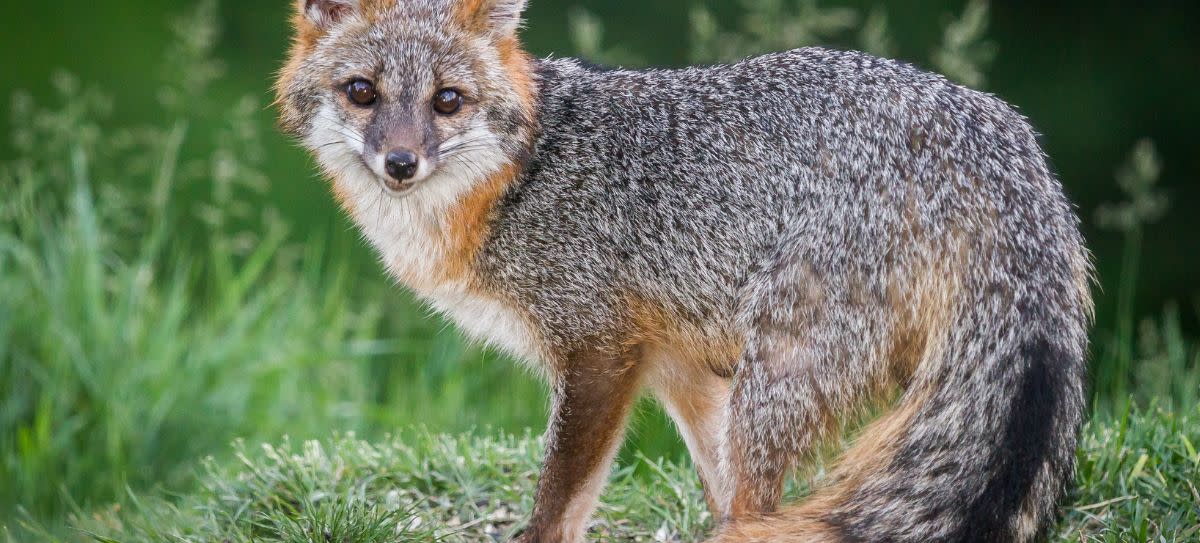 Gray Fox (Urocyon cinereoargenteus): The Gray Fox has a gray head and back, with russet-tinged ears, underbelly, and underside of its long fluffy tail. Their brown eyes are rimmed with black markings that run down either side of their muzzles. Gray Foxes have long bodies and short legs. Male Gray Foxes are larger than female foxes with the average adult Gray fox measuring up to 39.37 inches (about 100 centimeters) long. Gray Foxes breed December through March and have an average litter size of 4 babies, or kits. Gray Foxes inhabit dense forests and brushlands. Gray Foxes are solitary animals except during mating season and the subsequent raising of their kits. Gray Foxes place their dens in hollow logs, in between large rocks, and underground. Gray Foxes have the unique ability to climb trees and they have retractable claws, like domesticated cats do. Gray Foxes are omnivores, preying on mice, insects, rabbits, rats and foraging for fruit and carrion.
Gray Fox (Urocyon cinereoargenteus): The Gray Fox has a gray head and back, with russet-tinged ears, underbelly, and underside of its long fluffy tail. Their brown eyes are rimmed with black markings that run down either side of their muzzles. Gray Foxes have long bodies and short legs. Male Gray Foxes are larger than female foxes with the average adult Gray fox measuring up to 39.37 inches (about 100 centimeters) long. Gray Foxes breed December through March and have an average litter size of 4 babies, or kits. Gray Foxes inhabit dense forests and brushlands. Gray Foxes are solitary animals except during mating season and the subsequent raising of their kits. Gray Foxes place their dens in hollow logs, in between large rocks, and underground. Gray Foxes have the unique ability to climb trees and they have retractable claws, like domesticated cats do. Gray Foxes are omnivores, preying on mice, insects, rabbits, rats and foraging for fruit and carrion.
 Mountain Lion (Puma concolor): Mountain Lions are ochre-colored big cats with coarse fur. Their undersides are light in color. Their yellow eyes are rimmed in black and they have black streaks that run down along their white muzzles. Male Mountain Lions are larger than females with adult males measuring up to 7 ft 10 in (2.4 meters) in length while females measure up to 6 ft 9 inches (2.05 meters) in length. Mountain Lions are carnivores, consuming large mammals, like elk, deer; smaller animals like skunks, coyotes, rabbits; and livestock, like goats and calves. Mountain Lions silently stalk their prey before pouncing on their backs and crushing their necks with their powerful jaws. After catching their prey, mountain lions drag their prey to hide it and store it for later. Mountain Lions occupy a diverse range of habitats from evergreen forests, dry brush areas, grasslands, tropical forests, and swamps.
Mountain Lion (Puma concolor): Mountain Lions are ochre-colored big cats with coarse fur. Their undersides are light in color. Their yellow eyes are rimmed in black and they have black streaks that run down along their white muzzles. Male Mountain Lions are larger than females with adult males measuring up to 7 ft 10 in (2.4 meters) in length while females measure up to 6 ft 9 inches (2.05 meters) in length. Mountain Lions are carnivores, consuming large mammals, like elk, deer; smaller animals like skunks, coyotes, rabbits; and livestock, like goats and calves. Mountain Lions silently stalk their prey before pouncing on their backs and crushing their necks with their powerful jaws. After catching their prey, mountain lions drag their prey to hide it and store it for later. Mountain Lions occupy a diverse range of habitats from evergreen forests, dry brush areas, grasslands, tropical forests, and swamps.
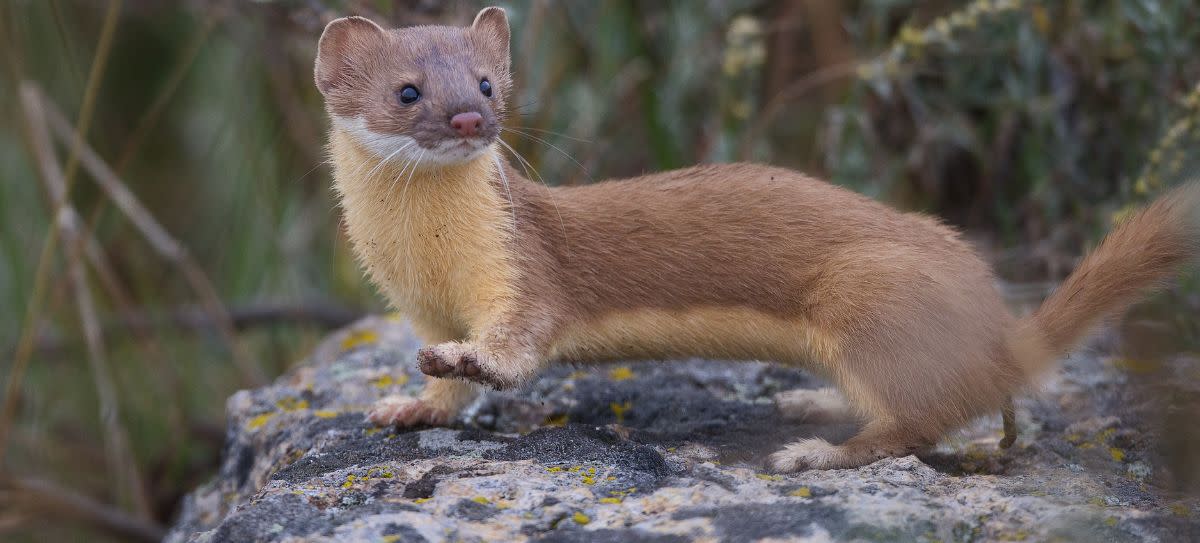 Long tailed weasel (Mustela frenata): The Long-tailed Weasel has a long body with short legs and a long tail. These weasels have brown coats with cream to yellow-colored bellies. They have short rounded ears and pink noses. Long-tailed Weasels shed their coats twice, turning completely white in the winter save for two ash brown lines that run vertically from their eyes. Female Long-tailed Weasels are smaller than males, with females measuring 11 to 14 inches long (28-36 centimeters) and males measuring 13 to 16 inches in length (33-41 centimeters). Long-tailed Weasels live in chaparral, agricultural areas, and wooded areas. They dig their burrows in hollow logs, under rocks, and sometimes even take over the burrows of their prey. Weasels live in solitude until it is time to mate. These weasels are omnivores, with small mammals, reptiles, and birds making up the majority of their diet, however, they enjoy berries and other fruit in the summer. Long-tailed Weasels stealthily stalk their prey before pouncing on their prey and giving them a fatal bite to the base of their skulls.
Long tailed weasel (Mustela frenata): The Long-tailed Weasel has a long body with short legs and a long tail. These weasels have brown coats with cream to yellow-colored bellies. They have short rounded ears and pink noses. Long-tailed Weasels shed their coats twice, turning completely white in the winter save for two ash brown lines that run vertically from their eyes. Female Long-tailed Weasels are smaller than males, with females measuring 11 to 14 inches long (28-36 centimeters) and males measuring 13 to 16 inches in length (33-41 centimeters). Long-tailed Weasels live in chaparral, agricultural areas, and wooded areas. They dig their burrows in hollow logs, under rocks, and sometimes even take over the burrows of their prey. Weasels live in solitude until it is time to mate. These weasels are omnivores, with small mammals, reptiles, and birds making up the majority of their diet, however, they enjoy berries and other fruit in the summer. Long-tailed Weasels stealthily stalk their prey before pouncing on their prey and giving them a fatal bite to the base of their skulls.
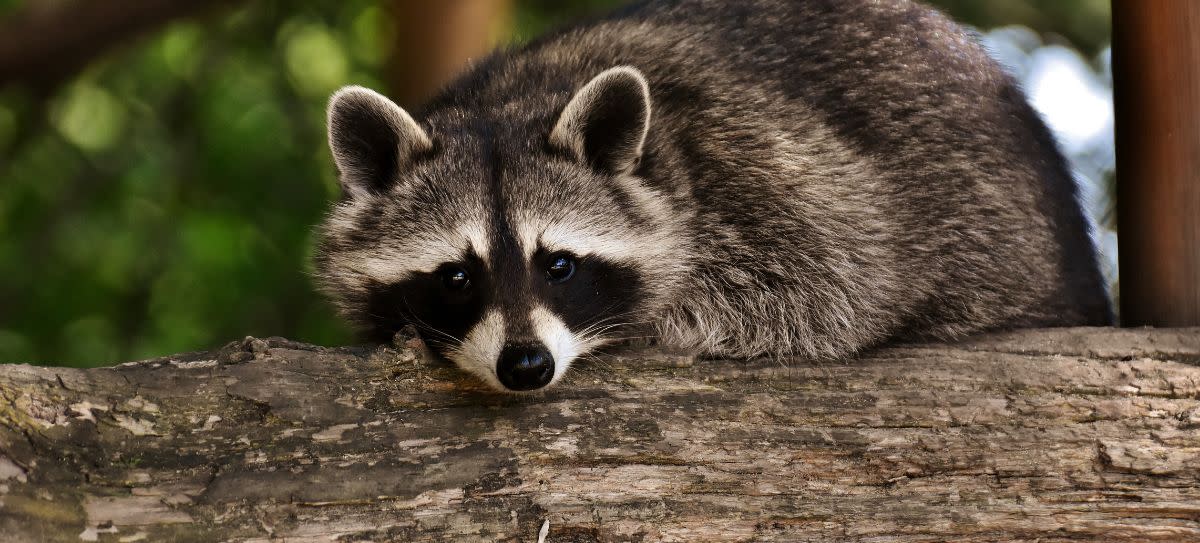 Raccoon (Procyon lotor): Raccoons have a grayish coat, with a dense undercoat that insulates them against the cold. Their most distinctive features are extremely dexterous front paws, a black facial mask, and a ringed tail. Raccoons are also recognized for their intelligence. Raccoons grow to weigh 11 to 13 pounds, are 23 to 38 inches long, and have a lifespan of 2 to 3 years in the wild. The gestation period for females is 65 days, with 2 to 5 kits being born in Spring, that will stay with the mother until the Fall. The raccoon is nocturnal and omnivorous, with a diet consisting of fruits, nuts, berries, insects, rodents, frogs, eggs, fish, and crayfish. Raccoons often forage through trash cans for food and through fields for corn. Predators include coyotes, gray wolves, large hawks, owls, and snakes, however, the two most common causes of death are by humans either hunting them or hitting them with their vehicles. Raccoons are important to the ecosystem because they eat fallen fruit, pests, and carrion, and for their distribution of plant seeds.
Raccoon (Procyon lotor): Raccoons have a grayish coat, with a dense undercoat that insulates them against the cold. Their most distinctive features are extremely dexterous front paws, a black facial mask, and a ringed tail. Raccoons are also recognized for their intelligence. Raccoons grow to weigh 11 to 13 pounds, are 23 to 38 inches long, and have a lifespan of 2 to 3 years in the wild. The gestation period for females is 65 days, with 2 to 5 kits being born in Spring, that will stay with the mother until the Fall. The raccoon is nocturnal and omnivorous, with a diet consisting of fruits, nuts, berries, insects, rodents, frogs, eggs, fish, and crayfish. Raccoons often forage through trash cans for food and through fields for corn. Predators include coyotes, gray wolves, large hawks, owls, and snakes, however, the two most common causes of death are by humans either hunting them or hitting them with their vehicles. Raccoons are important to the ecosystem because they eat fallen fruit, pests, and carrion, and for their distribution of plant seeds.
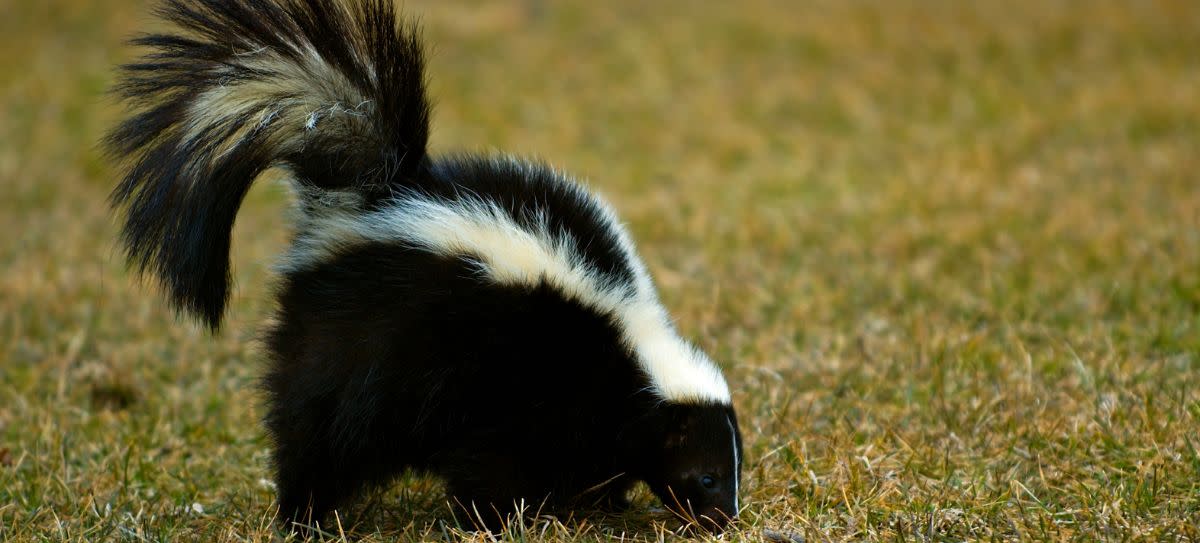 Striped Skunk (Mephitis mephitis): Striped Skunks are about the size of a domestic cat. They have small round ears, small black eyes, and long black fur with a recognizable white stripe down their backs, and an impressive bushy full tail. Their legs are short with five toes on each foot and their front feet have long, curved claws. Striped Skunks can grow from 8 to 19 inches long, and weigh from 1.5 to 13 pounds. The average lifespan of a skunk in the wild is about 2–3 years and they can live up to 15 years in captivity. Skunks make their dens above ground, in shaded areas, in tall grasses, hollow logs, wood or rock piles, under shrubs, in thickets, and under decks, buildings and rock walls. From May through June, female skunks give birth to a single litter of four to six kits that remain with their mother in their den until they are eight weeks old. Skunks’ diets vary from season to season. In warm months, the striped skunk will eat insects, beetles, bees, fruit and roots. During the colder months, the striped skunk will eat small mammals such as mice, shrews and chipmunks. Skunks have only a few predators, but those include coyotes, foxes, bobcats, cougars, large owls, and domestic dogs. Skunks are incredibly beneficial to the ecosystem because they are seed dispersers, and eat a variety of garden pests, including mice, voles, beetles, various larvae, wasps, crickets, and animal carcasses.
Striped Skunk (Mephitis mephitis): Striped Skunks are about the size of a domestic cat. They have small round ears, small black eyes, and long black fur with a recognizable white stripe down their backs, and an impressive bushy full tail. Their legs are short with five toes on each foot and their front feet have long, curved claws. Striped Skunks can grow from 8 to 19 inches long, and weigh from 1.5 to 13 pounds. The average lifespan of a skunk in the wild is about 2–3 years and they can live up to 15 years in captivity. Skunks make their dens above ground, in shaded areas, in tall grasses, hollow logs, wood or rock piles, under shrubs, in thickets, and under decks, buildings and rock walls. From May through June, female skunks give birth to a single litter of four to six kits that remain with their mother in their den until they are eight weeks old. Skunks’ diets vary from season to season. In warm months, the striped skunk will eat insects, beetles, bees, fruit and roots. During the colder months, the striped skunk will eat small mammals such as mice, shrews and chipmunks. Skunks have only a few predators, but those include coyotes, foxes, bobcats, cougars, large owls, and domestic dogs. Skunks are incredibly beneficial to the ecosystem because they are seed dispersers, and eat a variety of garden pests, including mice, voles, beetles, various larvae, wasps, crickets, and animal carcasses.
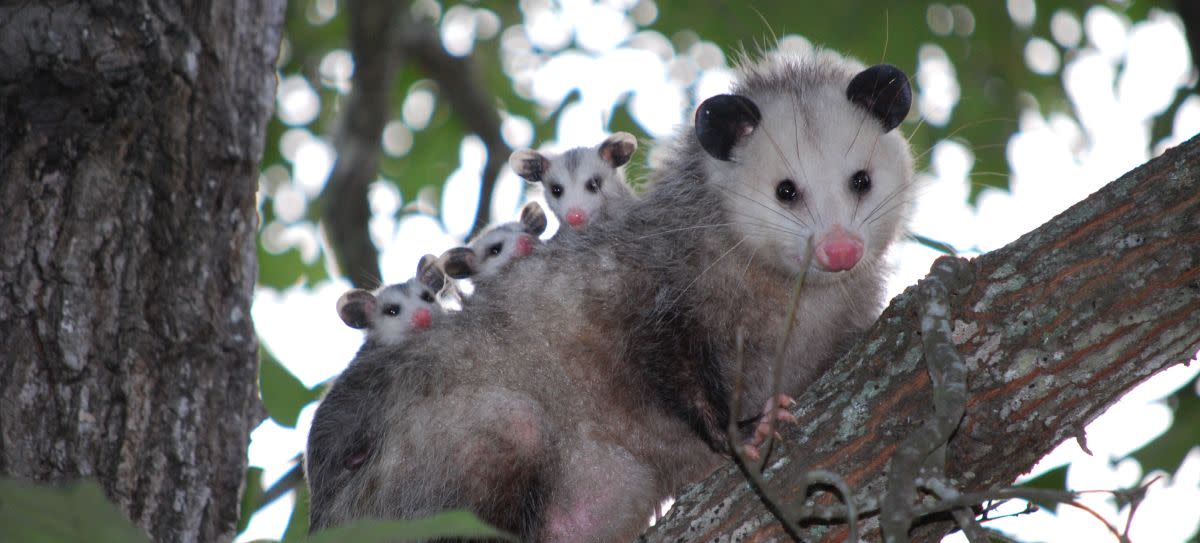 Virginia Opossum (Didelphis virginiana): The Virginia Opossum, also known as the North American opossum, is the only opossum living in North America. Opossums are marsupial mammals whose young are born undeveloped and then are carried and nursed in the mother’s pouch until they complete their development. Female opossums can give birth to 18 to 25 babies, each smaller than a honey bee. Opossums can live up to 4 years; males weigh from 1.8 to 14 pounds; females weigh .66 to 8.2 pounds; and they can measure from 14 to 37 inches in length. Opossums are omnivores and have 50 teeth, the highest number found in any land mammal. They have dexterous forefeet and their hindfeet have a large toe like a thumb for grasping. They use their tails to grasp and balance, allowing them to move from tree to tree, and young opossums can hang by their tails. When threatened, opossums have several escape strategies ranging from playing dead to hissing. Biting is rare for opossums, but it's possible for opossums to bite in their defense. Opossums are very beneficial to our environment and do not pose a danger to humans. Opossums are omnivores and scavengers, using their keen sense of smell to find food. They have a diet of insects, worms, dead animals, reptiles, amphibians, birds and their eggs, crustaceans, berries, fruits, rotting fruits and vegetables, small mammals, and garbage. They eat ticks and are important to controlling the amount of ticks in our environment. They eat snakes, including venomous snakes. Also, Opossums do not carry rabies, a common misconception. Their body temperature is lower than that of other mammals, making it impossible for the rabies virus to live and infect them. Because the North American Opossum is noted for its ability to live through snake bites, the protein contained in their blood could potentially be used to treat most snake bites because of its capability to neutralize the venom of major snake families.
Virginia Opossum (Didelphis virginiana): The Virginia Opossum, also known as the North American opossum, is the only opossum living in North America. Opossums are marsupial mammals whose young are born undeveloped and then are carried and nursed in the mother’s pouch until they complete their development. Female opossums can give birth to 18 to 25 babies, each smaller than a honey bee. Opossums can live up to 4 years; males weigh from 1.8 to 14 pounds; females weigh .66 to 8.2 pounds; and they can measure from 14 to 37 inches in length. Opossums are omnivores and have 50 teeth, the highest number found in any land mammal. They have dexterous forefeet and their hindfeet have a large toe like a thumb for grasping. They use their tails to grasp and balance, allowing them to move from tree to tree, and young opossums can hang by their tails. When threatened, opossums have several escape strategies ranging from playing dead to hissing. Biting is rare for opossums, but it's possible for opossums to bite in their defense. Opossums are very beneficial to our environment and do not pose a danger to humans. Opossums are omnivores and scavengers, using their keen sense of smell to find food. They have a diet of insects, worms, dead animals, reptiles, amphibians, birds and their eggs, crustaceans, berries, fruits, rotting fruits and vegetables, small mammals, and garbage. They eat ticks and are important to controlling the amount of ticks in our environment. They eat snakes, including venomous snakes. Also, Opossums do not carry rabies, a common misconception. Their body temperature is lower than that of other mammals, making it impossible for the rabies virus to live and infect them. Because the North American Opossum is noted for its ability to live through snake bites, the protein contained in their blood could potentially be used to treat most snake bites because of its capability to neutralize the venom of major snake families.
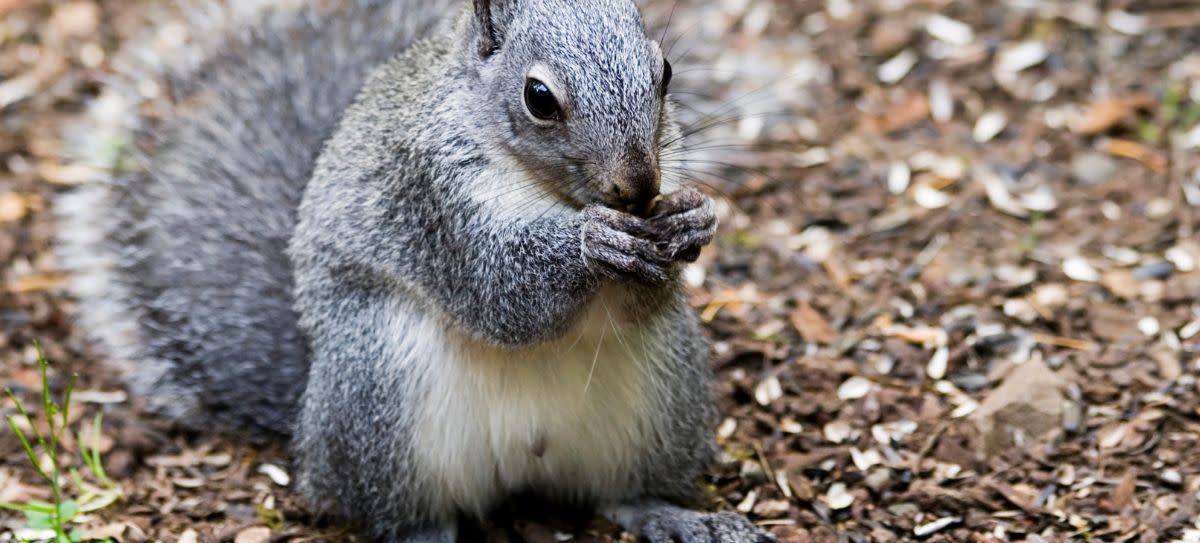 Western Gray Squirrel (Sciurus griseus): The Western Gray Squirrel is a tree squirrel
Western Gray Squirrel (Sciurus griseus): The Western Gray Squirrel is a tree squirrel
found along the western coast of the United States and Mexico. It has a rich silver gray coat and a full banner-like tail. Gray squirrels can weigh up to 15 ounces and measure from 18 to 24 inches long. They have a life expectancy of 1-2 years at birth, and up to 6 years if they reach adulthood. As herbivores, they feed primarily on seeds, nuts and acorns in addition to berries, fungus, bark, sap, and insects. Gray squirrels are beneficial members of woodland ecosystems because they forage for nuts, seeds, and flower buds, and are vehicles of seed dispersal.
INVERTEBRATES
Invertebrates are animals without backbones, which include butterflies, dragonflies, beetles, worms, bees, clams, mussels, and crabs. Invertebrates are some of the oldest animals in existence. They include protozoans ( i.e., amoeba), annelids (i.e., earthworms), echinoderms (i.e., starfish), molluscs (i.e., mussels), and arthropods (i.e., bees).
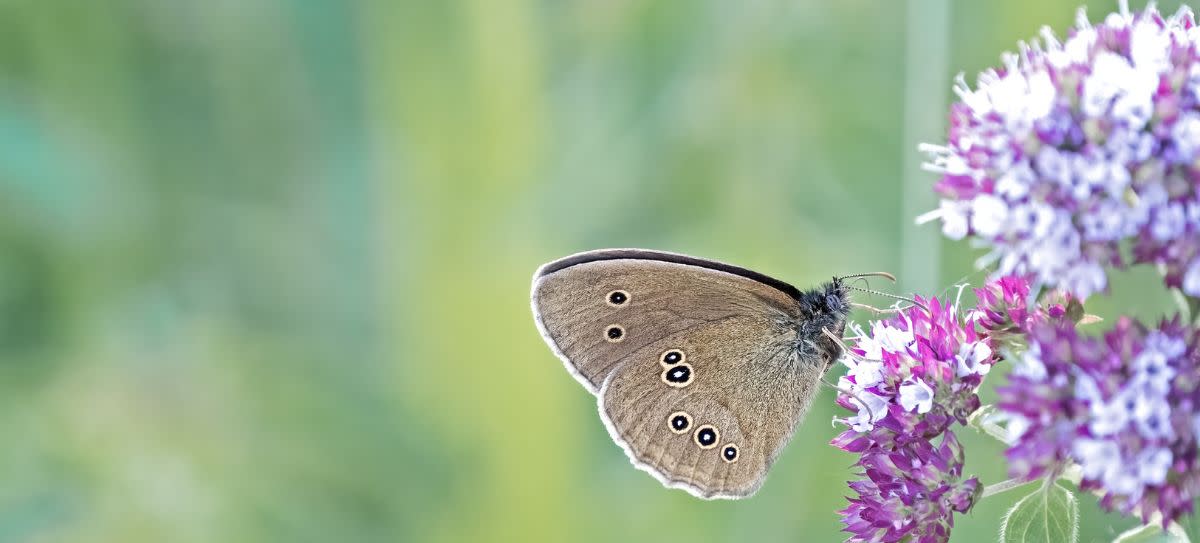 California Ringlet Butterfly (Coenonympha tullia california): California Ringlet Butterfly is a small cream or yellowish-brown butterfly with a forewing length of 14-18 mm. Due to its white coloration, this butterfly might be mistaken for a "white" (family Pieridae). It can be found in grassy habitats, including roadsides, woodlands, prairies, bogs, and arctic tundra.
California Ringlet Butterfly (Coenonympha tullia california): California Ringlet Butterfly is a small cream or yellowish-brown butterfly with a forewing length of 14-18 mm. Due to its white coloration, this butterfly might be mistaken for a "white" (family Pieridae). It can be found in grassy habitats, including roadsides, woodlands, prairies, bogs, and arctic tundra.
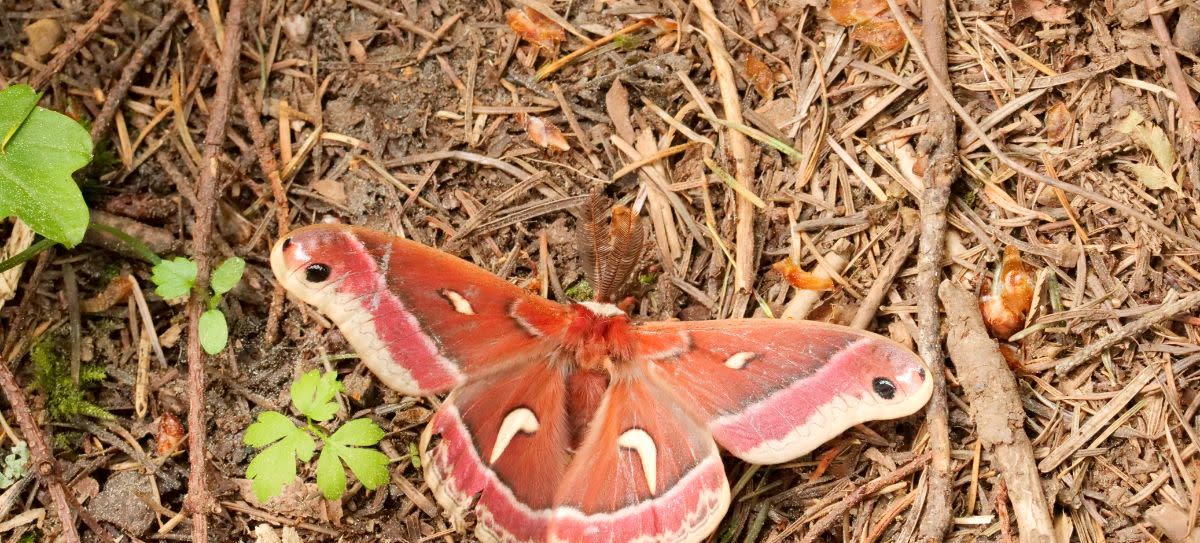 Ceanothus Moth (Hyalophora euryalus): Ceanothus Moths can be seen from January to July. Their opened wings are red to brownish red, and when closed, also red to brownish red, but with a black over scaling. A white spot shaped like a comma can be seen on the wing and when the wings are closed, the comma-shaped spot remains visible. Their average wingspan is 8.9 to 12.7 cm. The male’s antennae is more feathery than the female, with the female having a larger abdomen.
Ceanothus Moth (Hyalophora euryalus): Ceanothus Moths can be seen from January to July. Their opened wings are red to brownish red, and when closed, also red to brownish red, but with a black over scaling. A white spot shaped like a comma can be seen on the wing and when the wings are closed, the comma-shaped spot remains visible. Their average wingspan is 8.9 to 12.7 cm. The male’s antennae is more feathery than the female, with the female having a larger abdomen.
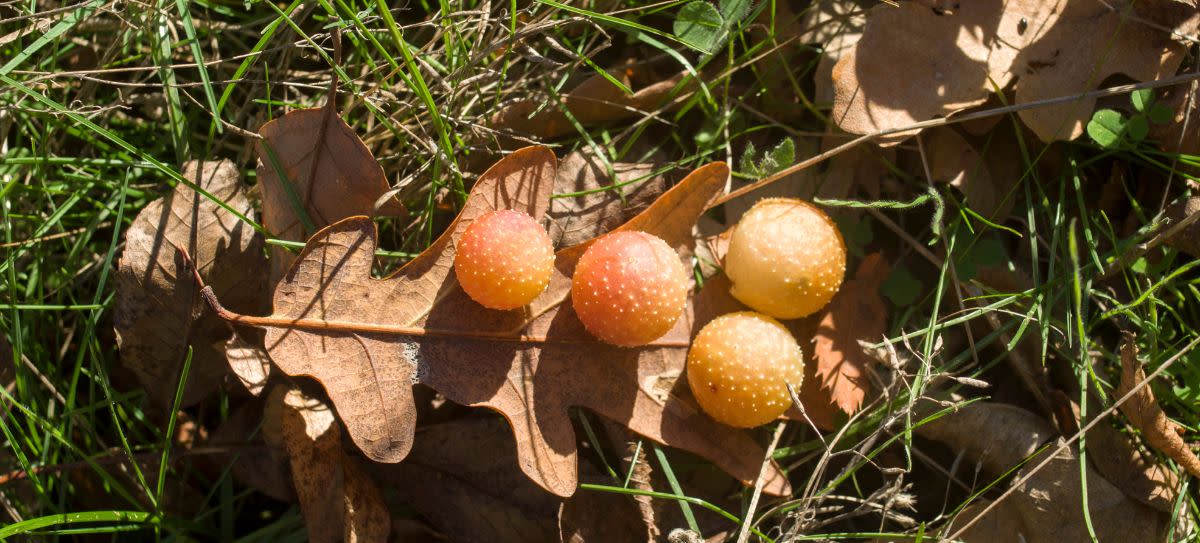 Oak Apple Gall Wasp (Atrusca bella): Between May and June when the female Oak Apple Gall Wasp lays her eggs in the leaf bud of an oak twig, a large, rough, buffish-brown, apple-like gall appears on the oak twigs. Inside the gall, tiny chambers house an Oak Apple Gall Wasp larvae that eventually eat their way out, and emerge in June and July.
Oak Apple Gall Wasp (Atrusca bella): Between May and June when the female Oak Apple Gall Wasp lays her eggs in the leaf bud of an oak twig, a large, rough, buffish-brown, apple-like gall appears on the oak twigs. Inside the gall, tiny chambers house an Oak Apple Gall Wasp larvae that eventually eat their way out, and emerge in June and July.
 Western Tiger Swallowtail Butterfly (Papilio rutulus): Western Tiger Swallowtail Butterfly is yellow with black stripes. Its wingspan is in the 2 1/4" to 3 7/8" range with a life span of about 6 to 14 days. It is seen in meadows, woodlands, stream sides and gardens and can be observed at mud spots in large numbers. Its host plants are mostly trees, including Cottonwood, aspens, poplars, alders, ashes, and willows.
Western Tiger Swallowtail Butterfly (Papilio rutulus): Western Tiger Swallowtail Butterfly is yellow with black stripes. Its wingspan is in the 2 1/4" to 3 7/8" range with a life span of about 6 to 14 days. It is seen in meadows, woodlands, stream sides and gardens and can be observed at mud spots in large numbers. Its host plants are mostly trees, including Cottonwood, aspens, poplars, alders, ashes, and willows.
PLANTS, FUNGI & LICHENS
Plants include grasses, trees, and shrubs that are photosynthetic, and contain green chlorophyll enabling them to convert energy from the sun into food; most plants are rooted in place. Fungi are plant-like organisms that do not make chlorophyll; fungi include mushrooms, yeast, and molds. Lichens are also fungi, but are a combination of fungi and alga, which is photosynthetic.
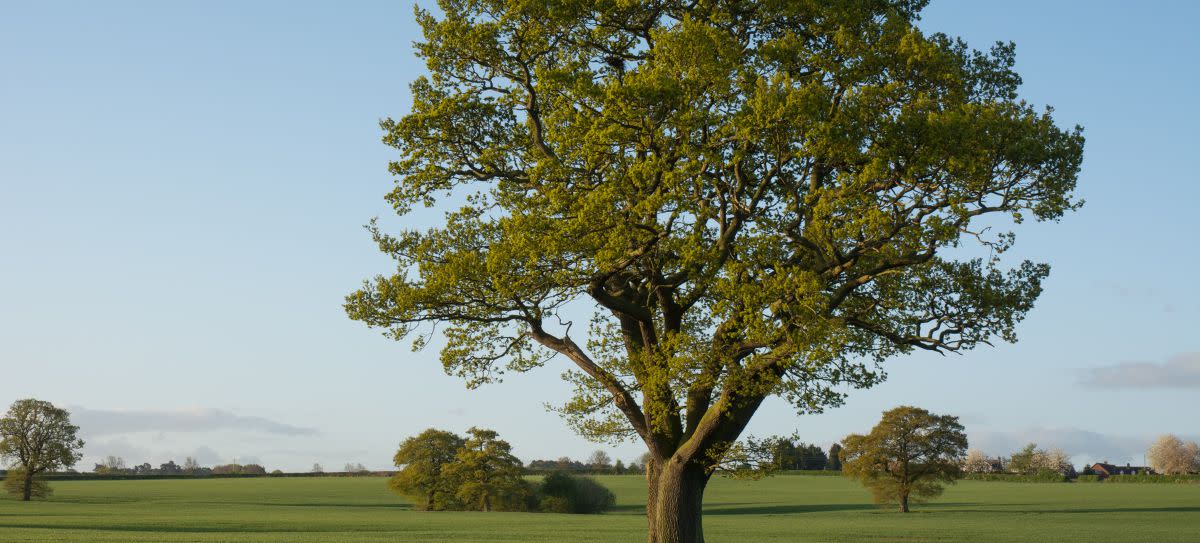 Blue Oak (Quercus douglasii): Blue Oaks are a species of oak native to California, commonly found in Coast Ranges and the Sierra Nevada. Blue oaks are California's most drought-tolerant deciduous oaks in the oaks woodland ecosystem. A medium-sized tree with a stout trunk and a wide, rounded crown, possessing crooked, sturdy branches, clothed in four inch, oval, blue-green leaves. In autumn, its foliage turns pastel shades of pink, orange and yellow.
Blue Oak (Quercus douglasii): Blue Oaks are a species of oak native to California, commonly found in Coast Ranges and the Sierra Nevada. Blue oaks are California's most drought-tolerant deciduous oaks in the oaks woodland ecosystem. A medium-sized tree with a stout trunk and a wide, rounded crown, possessing crooked, sturdy branches, clothed in four inch, oval, blue-green leaves. In autumn, its foliage turns pastel shades of pink, orange and yellow.
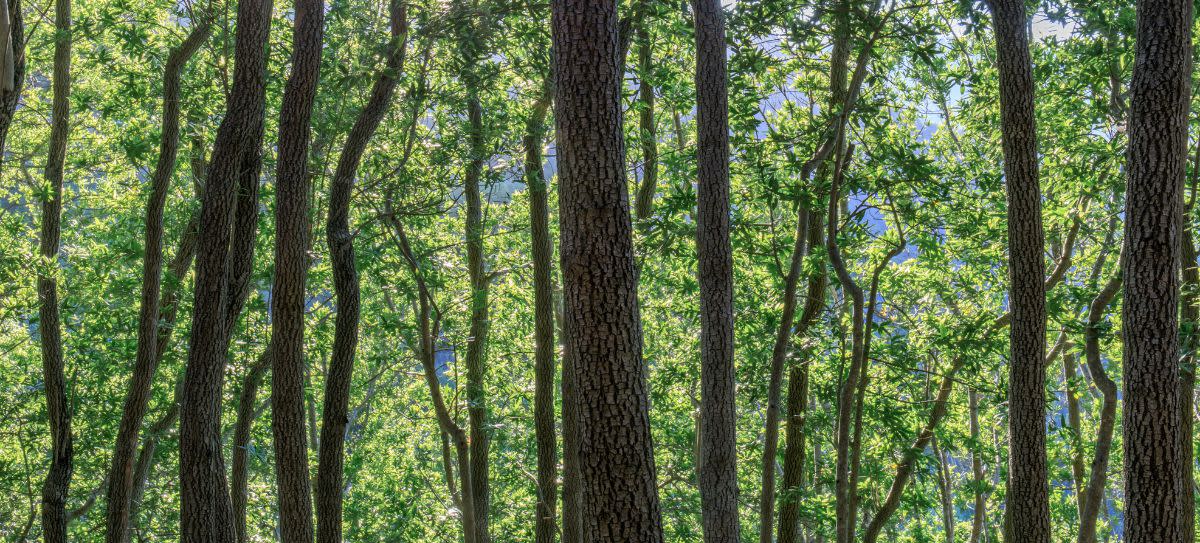 California Bay Laurel (Umbellularia californica): The California Bay Laurel is a large hardwood tree native to coastal forests extending into Oregon and the Sierra foothills of California. It is the sole species in the genus Umbellularia and is in the same family as avocados. With rounded, oblong, or pyramid-shaped crowns, the young trees have smooth bark that turns flaky and scaly as they age.
California Bay Laurel (Umbellularia californica): The California Bay Laurel is a large hardwood tree native to coastal forests extending into Oregon and the Sierra foothills of California. It is the sole species in the genus Umbellularia and is in the same family as avocados. With rounded, oblong, or pyramid-shaped crowns, the young trees have smooth bark that turns flaky and scaly as they age.
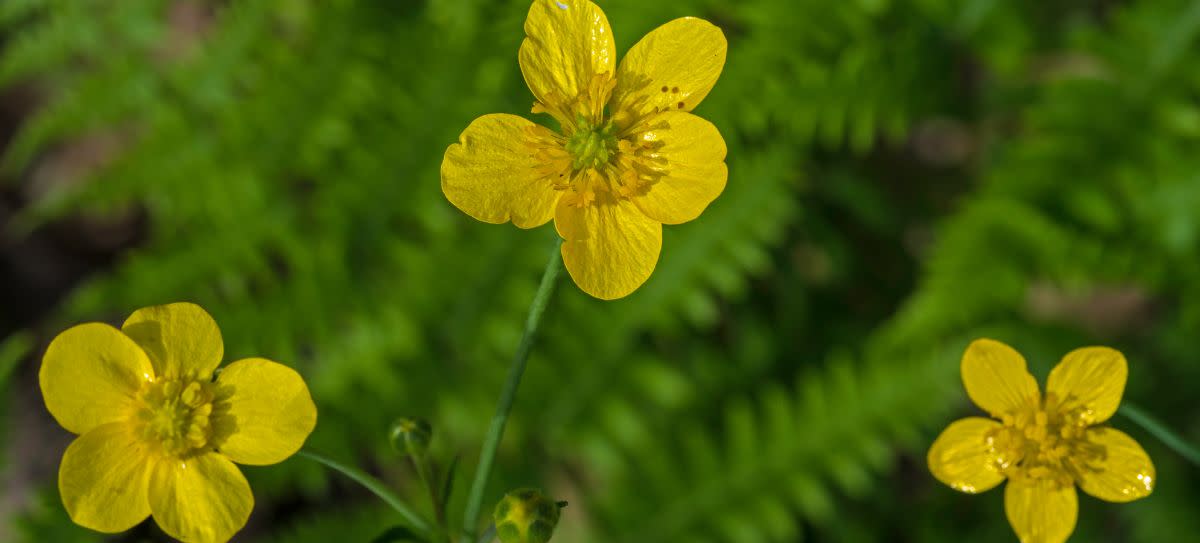 California Buttercup (Ranunculus californicus): The California Buttercup is a native flowering plant of the buttercup family Ranunculaceae, common in many habitats, including California woodlands and chaparral. From late winter to spring, this cheery perennial is prized for its shiny, deep yellow flowers. Flowers feature overlapping petals surrounding a center of yellow stamens.
California Buttercup (Ranunculus californicus): The California Buttercup is a native flowering plant of the buttercup family Ranunculaceae, common in many habitats, including California woodlands and chaparral. From late winter to spring, this cheery perennial is prized for its shiny, deep yellow flowers. Flowers feature overlapping petals surrounding a center of yellow stamens.
 California Poppy (Eschscholzia californica): The California Poppy, the official state flower of California, has a long green stem with green leaves and is crowned with a silky orange blossom. These flowers are self-propagating, meaning that once they’re pollinated, their seed pods dry up and explode, sending their seeds into the surrounding area where they will grow into these delicate orange blooms. California poppies bloom from spring to early summer with April being the best month to see them. Experience these beautiful California gems at the Pismo Preserve.
California Poppy (Eschscholzia californica): The California Poppy, the official state flower of California, has a long green stem with green leaves and is crowned with a silky orange blossom. These flowers are self-propagating, meaning that once they’re pollinated, their seed pods dry up and explode, sending their seeds into the surrounding area where they will grow into these delicate orange blooms. California poppies bloom from spring to early summer with April being the best month to see them. Experience these beautiful California gems at the Pismo Preserve.
 California Lilac (Ceanothus): The California Lilac is a member of the buckthorn family, such as buckbrush and soap bush and grows 2 to 20 feet tall. During the late spring and early summer, lilacs bloom deep blue, purple, or white flowers with green leaves. Their strong fragrance attracts birds, beneficial insects, and pollinators.
California Lilac (Ceanothus): The California Lilac is a member of the buckthorn family, such as buckbrush and soap bush and grows 2 to 20 feet tall. During the late spring and early summer, lilacs bloom deep blue, purple, or white flowers with green leaves. Their strong fragrance attracts birds, beneficial insects, and pollinators.
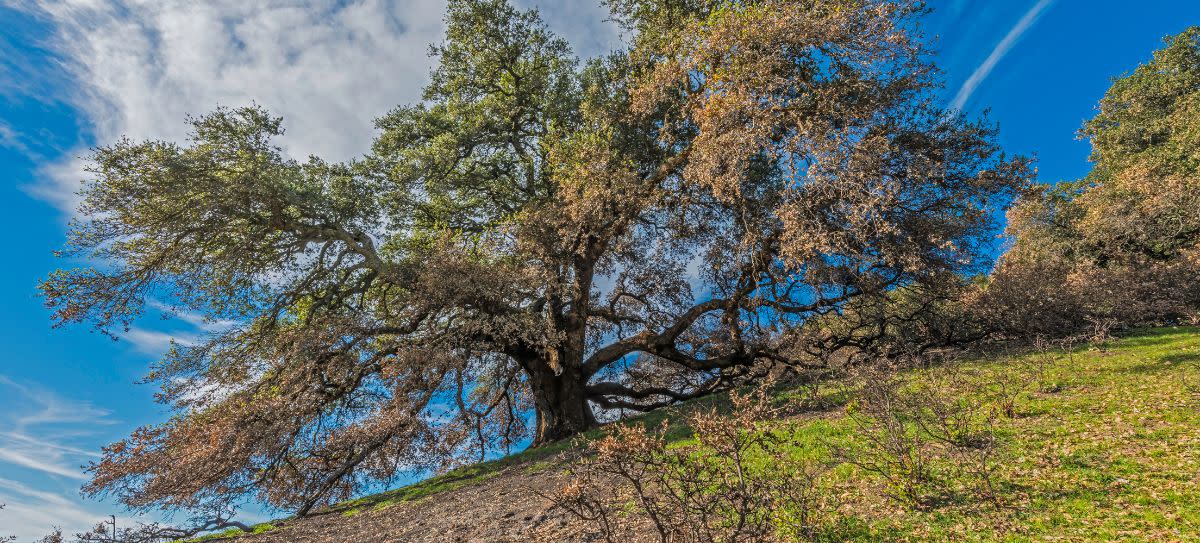 Coast Live Oak (Quercus agrifolia): The Coast Live Oak, often referred to as the California Live Oak, is a highly variable, evergreen oak tree native to the California Floristic Province. The California Floristic Province is a region with a mediterranean climate on the Pacific coast of North America with unique endemic flora and fauna that extends from Santa Barbara to Baja California. It is a medium-sized tree but can be shrubby, depending on age and growing location.
Coast Live Oak (Quercus agrifolia): The Coast Live Oak, often referred to as the California Live Oak, is a highly variable, evergreen oak tree native to the California Floristic Province. The California Floristic Province is a region with a mediterranean climate on the Pacific coast of North America with unique endemic flora and fauna that extends from Santa Barbara to Baja California. It is a medium-sized tree but can be shrubby, depending on age and growing location.
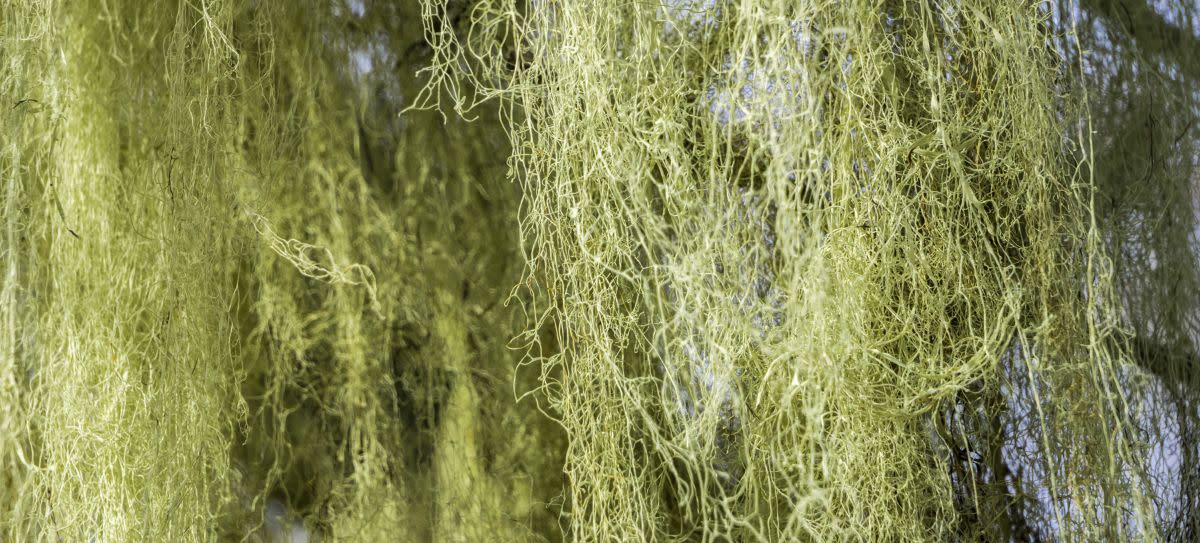 Lace Lichen (Ramalina menziesii): Lace Lichen or fishnet lichen, is pale yellow-green to gray-green, with a lobed, leaflike shape, that becomes a deeper green when wet. Growing up to three feet long, it is found hanging from bark and twigs in a distinctive net-like or lace-like pattern, unlike any other lichen in North America.
Lace Lichen (Ramalina menziesii): Lace Lichen or fishnet lichen, is pale yellow-green to gray-green, with a lobed, leaflike shape, that becomes a deeper green when wet. Growing up to three feet long, it is found hanging from bark and twigs in a distinctive net-like or lace-like pattern, unlike any other lichen in North America.
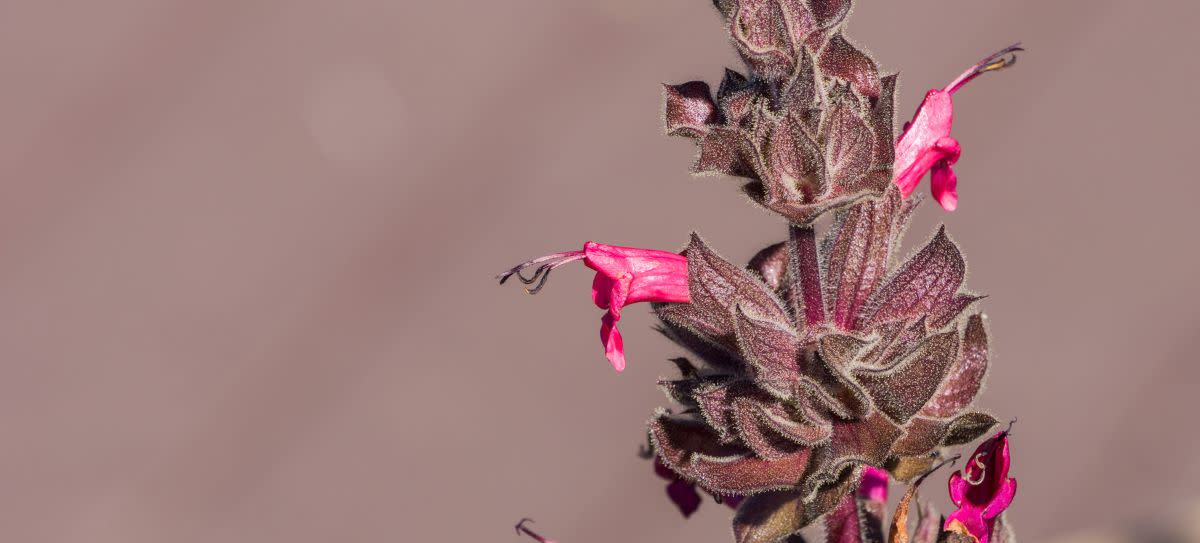 Hummingbird Sage (Salvia spathacea): Hummingbird Sage is a fruity-scented dark green sage beaded with magenta-colored flowers. This fragrant sage blooms from March to May. Hummingbird Sage is an important plant for many pollinators, offering nectar, pollen, and hosts for larvae.
Hummingbird Sage (Salvia spathacea): Hummingbird Sage is a fruity-scented dark green sage beaded with magenta-colored flowers. This fragrant sage blooms from March to May. Hummingbird Sage is an important plant for many pollinators, offering nectar, pollen, and hosts for larvae.
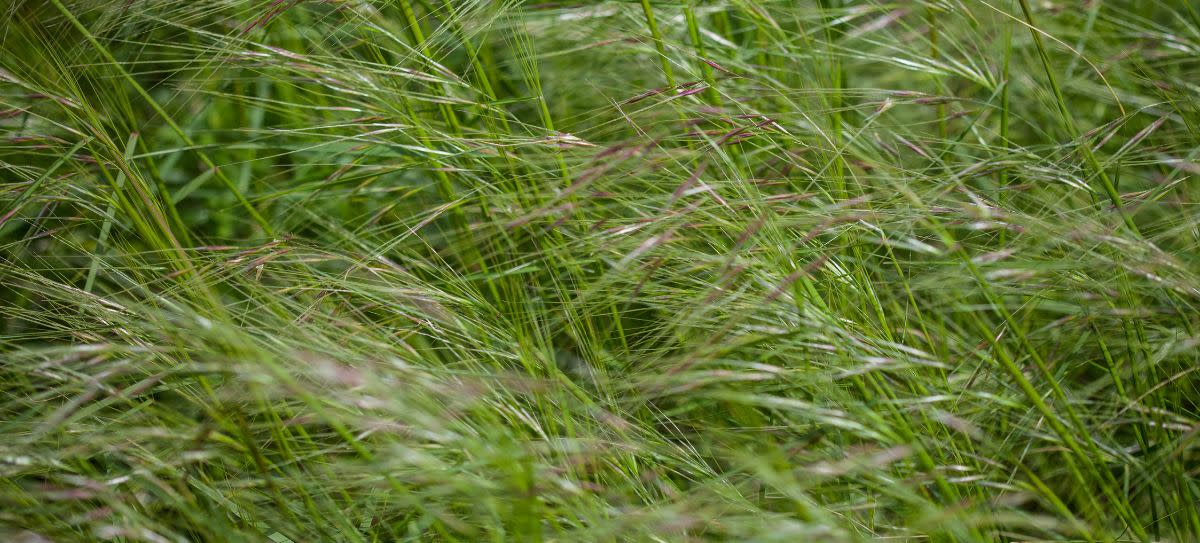 Purple Needlegrass (Nassella pulchra): Purple Needlegrass, once nominated to be the state grass of California, stays green all year. A densely tufted, long-lived, perennial with characteristically long awns, it grows up 2 to 3 feet tall. Purple Needlegrass is an important food source for deer, elk, and other wildlife. Native Americans used purple needlegrass as a food source and for basket weaving material.
Purple Needlegrass (Nassella pulchra): Purple Needlegrass, once nominated to be the state grass of California, stays green all year. A densely tufted, long-lived, perennial with characteristically long awns, it grows up 2 to 3 feet tall. Purple Needlegrass is an important food source for deer, elk, and other wildlife. Native Americans used purple needlegrass as a food source and for basket weaving material.
 Toyon or Christmas Berry (Heteromeles arbutifolia): The Toyon, also known as the Christmas Berry, is a shrub or tree with glossy dark-green leaves ornamented with clusters of small, white blooms in summer and bright red berries in winter. The white flowers of the Toyon provide sustenance for insects and the red berries provide food for birds, coyotes, and other creatures.
Toyon or Christmas Berry (Heteromeles arbutifolia): The Toyon, also known as the Christmas Berry, is a shrub or tree with glossy dark-green leaves ornamented with clusters of small, white blooms in summer and bright red berries in winter. The white flowers of the Toyon provide sustenance for insects and the red berries provide food for birds, coyotes, and other creatures.
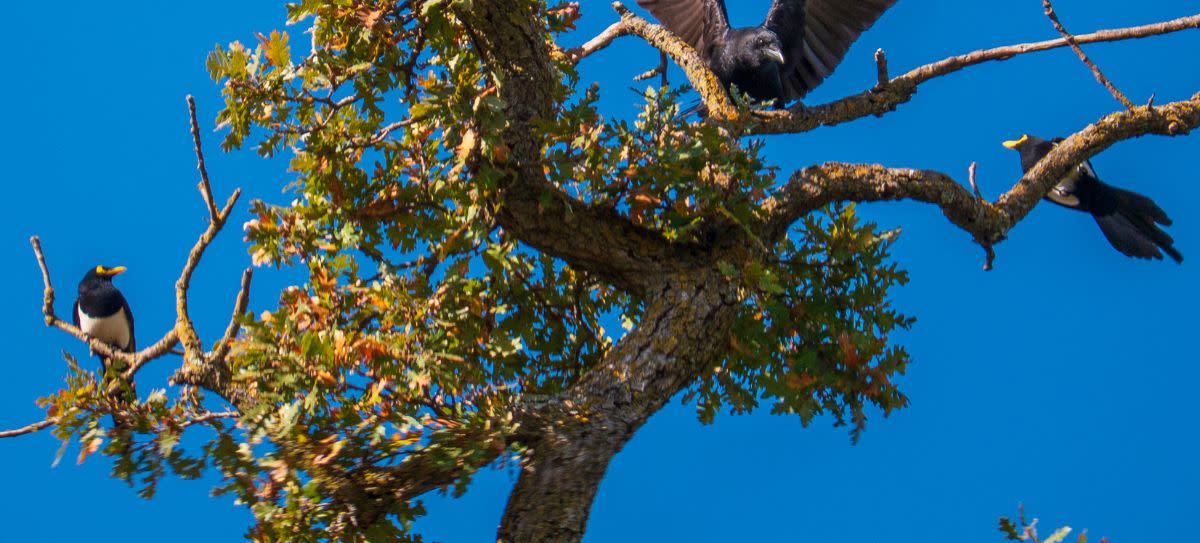 Valley Oak (Quercus lobata): The Valley Oak or Roble, is the largest North American Oak that can grow up to 100 feet tall and 600 years of age. These Oaks have a dark gray, ridged bark; and a trunk that can grow to 6 to 9 feet in diameter, with branches that spread and arch, producing a leafless silhouette in winter. During Autumn, its leaves turn yellow to light orange color, becoming brown late in the season. Their acorns fall in October, providing food for birds, including the Acorn Woodpecker, Western Scrub Jay, Yellow-billed Magpie, and California ground squirrels. In spring, matte green leaves, five to ten centimeters in length, round and deeply lobed, are covered with soft velvety fuzz. If a fresh leaf is rubbed or broken, it gives off fresh forest fragrance. These oaks are found in dense riparian forests, open foothill woodlands and valley savannas.
Valley Oak (Quercus lobata): The Valley Oak or Roble, is the largest North American Oak that can grow up to 100 feet tall and 600 years of age. These Oaks have a dark gray, ridged bark; and a trunk that can grow to 6 to 9 feet in diameter, with branches that spread and arch, producing a leafless silhouette in winter. During Autumn, its leaves turn yellow to light orange color, becoming brown late in the season. Their acorns fall in October, providing food for birds, including the Acorn Woodpecker, Western Scrub Jay, Yellow-billed Magpie, and California ground squirrels. In spring, matte green leaves, five to ten centimeters in length, round and deeply lobed, are covered with soft velvety fuzz. If a fresh leaf is rubbed or broken, it gives off fresh forest fragrance. These oaks are found in dense riparian forests, open foothill woodlands and valley savannas.
KEEP THE TRAILS SAFE AND CLEAN:
- Keep dogs on the leash and pick up their waste.
- Dispose of trash in receptacles or take your trash with you.
- Talk while hiking to alert animals of your approach. Both talking and the vibrations of your footsteps alert animals you are there so they have a chance to move to safety.
- Stay on the trail to avoid disturbing nests and dens.
FOLLOW THESE IMPORTANT CALIFORNIA STATE PARKS HIKING SAFETY GUIDELINES:
- Each year, thousands of people discover that walking and hiking on California State Park trails is safe and healthy fun, if you follow a few tips:
- Hike with a friend or family member. The companionship in the great outdoors is fun and you can encourage one another to meet your fitness goals.
- Take plenty of drinking water. Leave stream, river and lake water for the park wildlife. Although it looks clean and refreshing, mountain stream water can make you ill.
- Let someone back at camp or at home know where you are going and when you plan on returning. Take a mobile phone for emergencies only or to let them know you have returned safely.
- Don’t walk off-trail. Cutting across switchbacks erodes the hillside and eventually destroys the trail. Plus, walking off-trail increases your chance of suffering an injury or getting lost
- Wildlife lives in all of our state parks, even near urban areas. Although rare, black bears, mountain lions, and rattlesnakes may be seen. Whenever you encounter wildlife on the trail, keep your distance back away slowly, and do not run. Report your sightings to a State Park Ranger.
- Poison oak is a common plant throughout much of California. Learn to identify its shiny, three-leaf pattern and avoid touching it. If you touch poison oak, wash immediately with water and mild soap. Pat dry with a clean towel.
RATTLESNAKE PRECAUTIONS:
First, back away. Rattlesnakes aren’t aggressive to humans unless threatened or frightened. They eat mice and rodents and are shy of bigger animals. If they sense you, they will usually try to escape. Give them space to do so. Don’t wave things at them because that may irritate them. Don’t try to push them off the trail with a stick because that’s how people do get bitten. Shouting won’t scare them off either because they don’t have external ears but they can “hear” really well by picking up vibrations in their jaws and bones. They can sense the impact of feet on ground, which helps them escape before you get there. If they don’t move off on their own, you can try stomping at a safe distance to give them the signal.
Visit the Pismo Preserve year-round, a 900-acre nature preserve open to the public for hiking, (including docent-led hikes), runs, bike rides & horse rides. The Pismo Preserve is owned and maintained by the Land Conservancy of San Luis Obispo County and is located at 80 Mattie Rd, Pismo Beach, CA 93449.
Sources: Land Conservancy of San Luis Obispo County, All About Birds.Org, California State Parks, The Rattlesnake Conservancy, Merriam Webster, Encyclopedia Britannica, The Atlantic, Animalia.bio



